Filled with towering mountains, pristine alpine lakes, and expansive pine forests, Rocky Mountain National Park showcases Colorado at its best. In this guide, we’ll break down the best things to do in Rocky Mountain National Park, including helpful tips and advice to make the most of your visit!
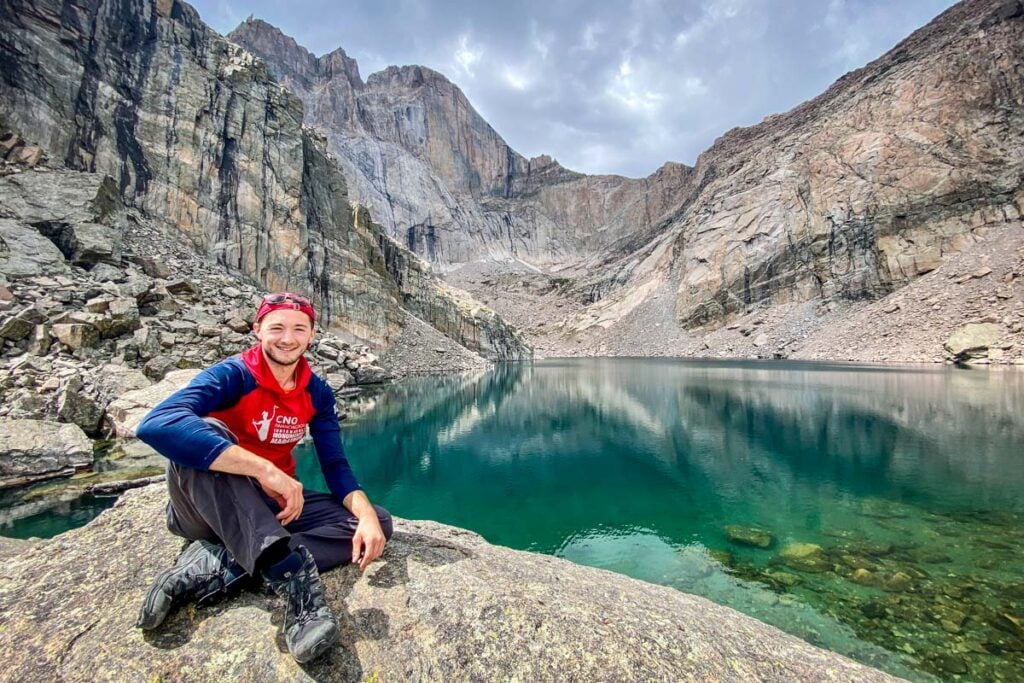
Co-written by Guest Author: Paul Fuchs
Rocky Mountain National Park showcases Colorado at its absolute best. Towering mountains, alpine lakes, and endless pine forests define this beautiful and diverse landscape.
Every year, it is one of the most visited national parks… and for good reason!
The park’s natural beauty and countless outdoor activities make it a destination for nature enthusiasts around the world. The amount of hiking, rock climbing, and sightseeing in the park could keep you busy for a lifetime.
In this guide, we’ll break down the absolute best things to do in Rocky Mountain National Park. The park offers something for everybody, no matter their age, skill level, or interests. We’ll also share tips to avoid the crowds, items to pack, and everything else you need to know to have a successful visit.
Rocky Mountain National Park Guide
- Park overview
- Things to do
- How to get there
- Getting around in the park
- Areas of Rocky Mountain National Park
- Rocky Mountain National Park map
- Entrance fees and tickets
- Timed entry permits
- Best time to visit
- How many days to spend in the park
- Where to stay
- What to pack
- Tips for visiting RMNP
- Roundup of things to do in RMNP
Rocky Mountain National Park at a glance
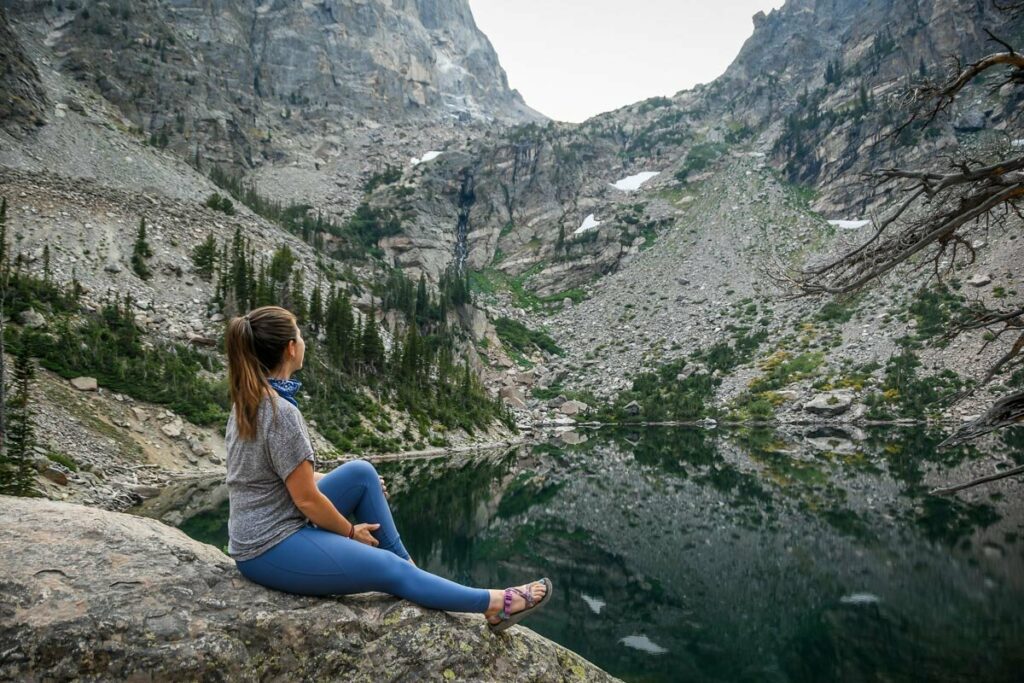
- Open: Year-round, but much of the park is closed in winter and spring due to snowfall. Shuttles, campgrounds, and Trail Ridge Road are all shut down during this time
- Entrance Fee: $30/vehicle, $25/motorcycle, $15/hiking & biking, or free with your America the Beautiful Pass
- Wildlife: Elk, mule deer, pikas, black bears, bighorn sheep, coyotes, mountain lions, turkeys
- Established: January 26, 1915
- Ancestral Lands: Both the Ute and Arapaho tribes utilized the land that later became Rocky Mountain National Park for hunting and foraging. Other tribes occasionally hunted in the area, including Shoshone, Apache, Cheyenne, and Sioux. Most Native Americans had left the area – either voluntarily or by force – by the late 19th century
- Area: 265,807 acres
As the name implies, this national park protects a section of the Rocky Mountains. The park houses Longs Peak – its resident 14er, visible from Denver – and a number of 13ers lining the Continental Divide.
Psst! A “14er” is Colorado’s casual name for a peak that reaches over 14,000 ft in elevation.
Nearly 150 lakes reside in the park, and hundreds of animal species call the park “home.” It is an impressive nature reserve, one that millions of people visit each year.
In recent years, climate change has impacted Rocky Mountain National Park in increasingly concerning ways.
Our warming planet has led to shorter winters in the parks. This means less snowfall, drier summers, and therefore an increased risk of wildfires. Warmer temperatures also promote larger populations of mountain pine beetles, which threaten the park’s beautiful forests.
The glaciers left in the park – of which there are few – are melting rapidly. For these reasons, RMNP is a living, breathing case study in the importance of fighting climate change. These sad truths also act as a motivator to visit the park while it is still healthy!
Best things to do in Rocky Mountain National Park
If you’re looking for the very best things to do in Rocky Mountain National Park, here are our top 5 recommendations:
- Explore the Bear Lake Road Corridor
- Visit the Alpine Visitor Center
- Drive Trail Ridge Road
- Summit Longs Peak
- Spot wildlife
- Swim in an alpine lake
Keep reading for more detailed information on each of these activities and more ideas of fun things to do in Rocky Mountain National Park.
1. Explore the Bear Lake Road Corridor*
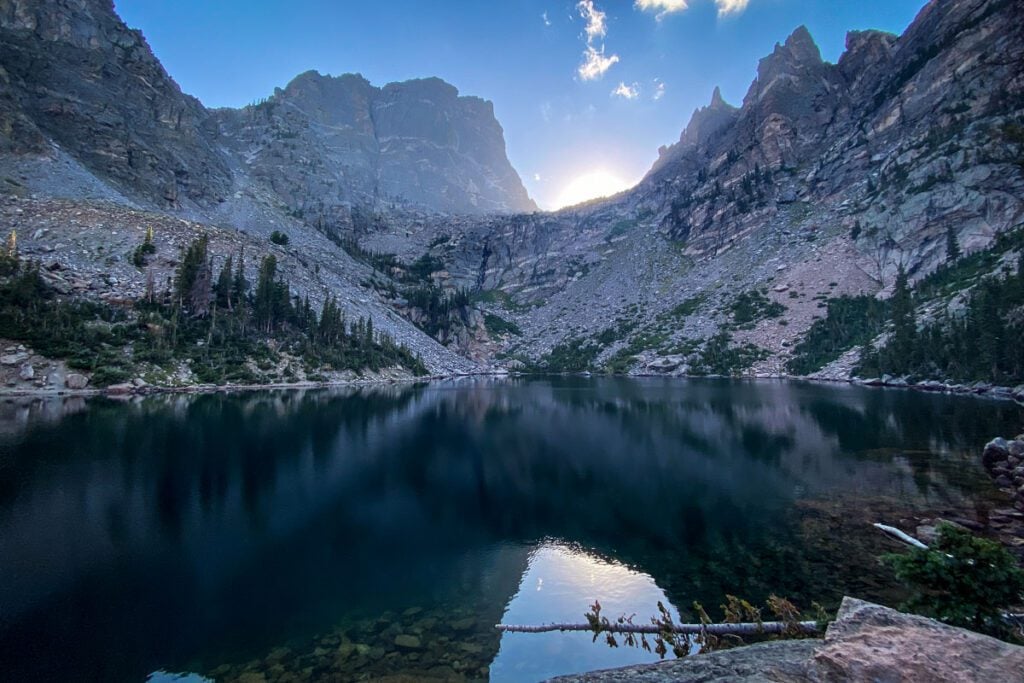
If you only have a few hours in the park, visit the Bear Lake area! This is one of the most popular things to do in Rocky Mountain National Park.
As such, the trails here can be crowded and the parking lots packed, especially on weekends. However, the beautiful hikes and scenery here will help you forget about the tourists.
At Bear Lake, you can find a high concentration of stunning lakes, beautiful forests, plentiful wildlife, and jaw-dropping views of Longs Peak.
The Bear Lake area houses a high concentration of some of the best hikes in Rocky Mountain National Park, including:
- Nymph, Dream, & Emerald Lake Trail (3.2 miles, 698 feet elev. gain)
- Bear Lake Nature Trail (0.7 miles, 49 feet elev. gain)
- Lake Haiyaha (4.0 miles, 846 feet elev. gain)
- Alberta Falls (1.2 miles, 160 feet elev. gain)
- Sky Pond via Glacier Gorge Trail (9.4 miles, 1,758 feet elev. gain)
- Flattop Mountain (8.2 miles, 2,870 feet elev. gain)
In addition, the Bear Lake area houses much of the national park’s bouldering opportunities. More on that later.
When planning a visit to Bear Lake, remember to reserve a Timed Entry + permit. Consider using the park’s Park & Ride system, since parking lots fill quickly. If you want to avoid crowds, start early or late in the day, and visit during weekdays.
*You will need a Timed Entry + permit to visit the Bear Lake Road Corridor. See our section on timed entry permits below about the difference and how to reserve yours.
2. Drive Trail Ridge Road
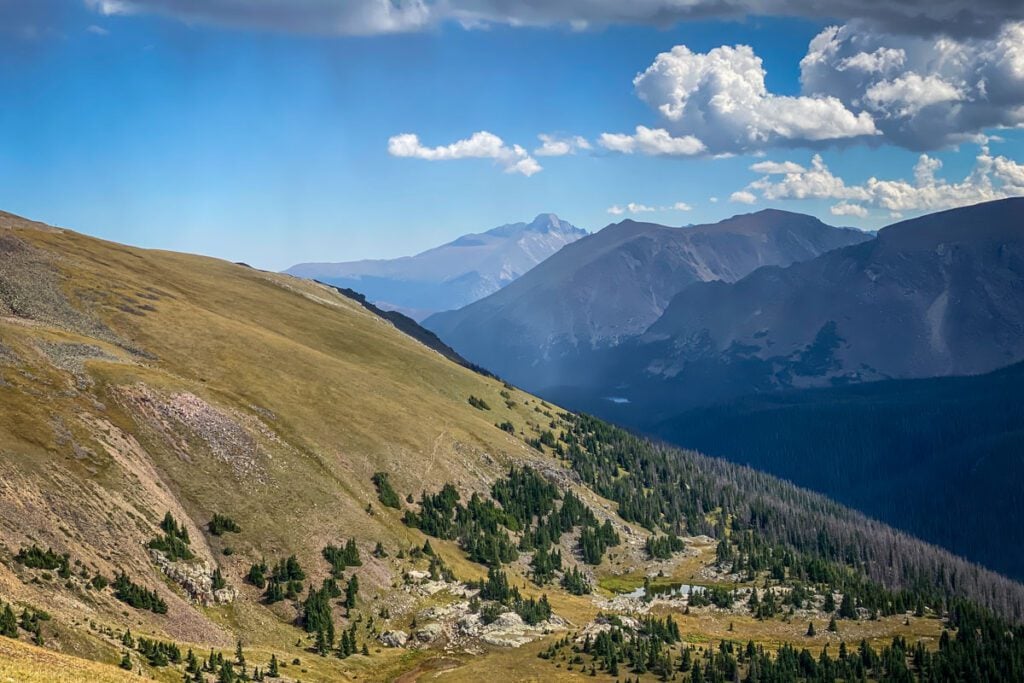
Trail Ridge Road connects Rocky Mountain National Park’s east and west sides. It guides visitors through the alpine tundra, a fascinating high-elevation ecosystem in the park. In the tundra, trees disappear and wildlife – especially pika – are common. Here, you’ll find sweeping views of the park and great vistas of Longs Peak.
There are several must-see stops along the road, including Rock Cut Trail, Lava Cliffs, the Alpine Visitor Center, and Poudre Lake. The road is typically closed in the winter due to heavy snowfall.
It takes about 3 hours to drive out and back on this 48-mile road. Plan for at least 4-6 hours to stop at all the stops and complete some short hikes.
3. Visit the Alpine Visitor Center
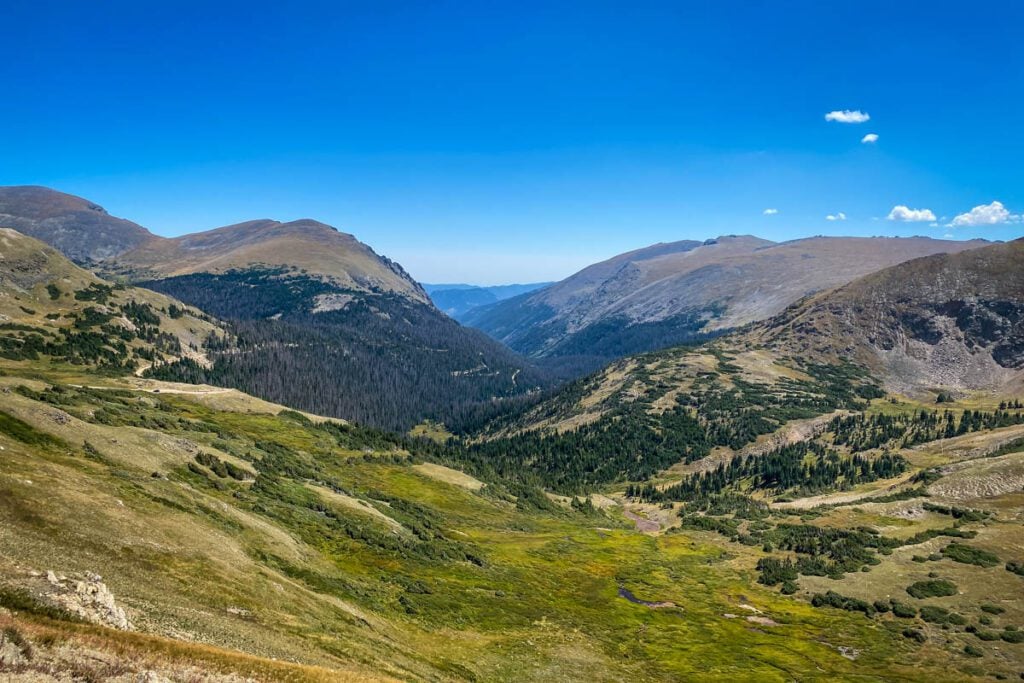
The highest visitor center in the National Park Service sits at 11,796 feet in elevation. That is Rocky Mountain National Park’s own Alpine Visitor Center!
The Alpine Visitor Center sits along Trail Ridge Road. It features a great view of Old Fall River Road and the surrounding tundra. Stop here to get a national park passport stamp, look around the museum, and get a bite to eat.
You can also climb the short and steep Alpine Ridge Trail, which leaves from the visitor center’s parking lot. The top of this trail provides a vista of the park to the north.
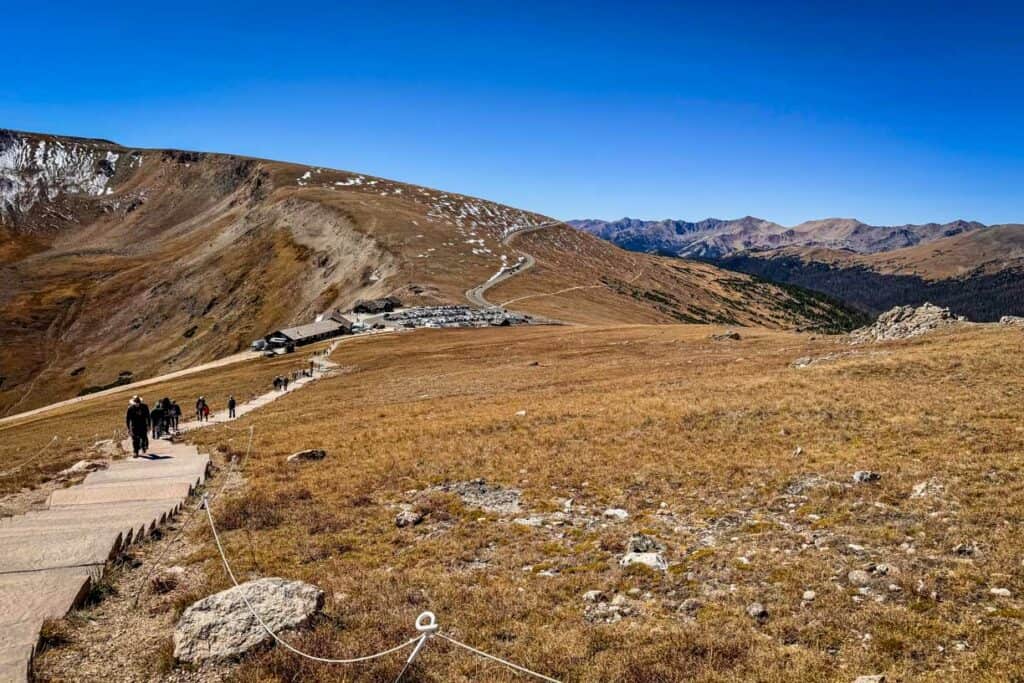
Consider driving to the Alpine Visitor Center from the eastern side of the park via the one-way Old Fall River Road and returning via Trail Ridge Road, instead of driving out-and-back on just Trail Ridge Road.
If you visit the park in winter, the Alpine Visitor Center will be closed. During this time, visit the Beaver Meadows Visitor Center – the park’s headquarters – instead.
Looking for a way to fit this all in? Our 3 day Rocky Mountain National Park itinerary has all of the logistics and details planned for you!
4. Summit Longs Peak
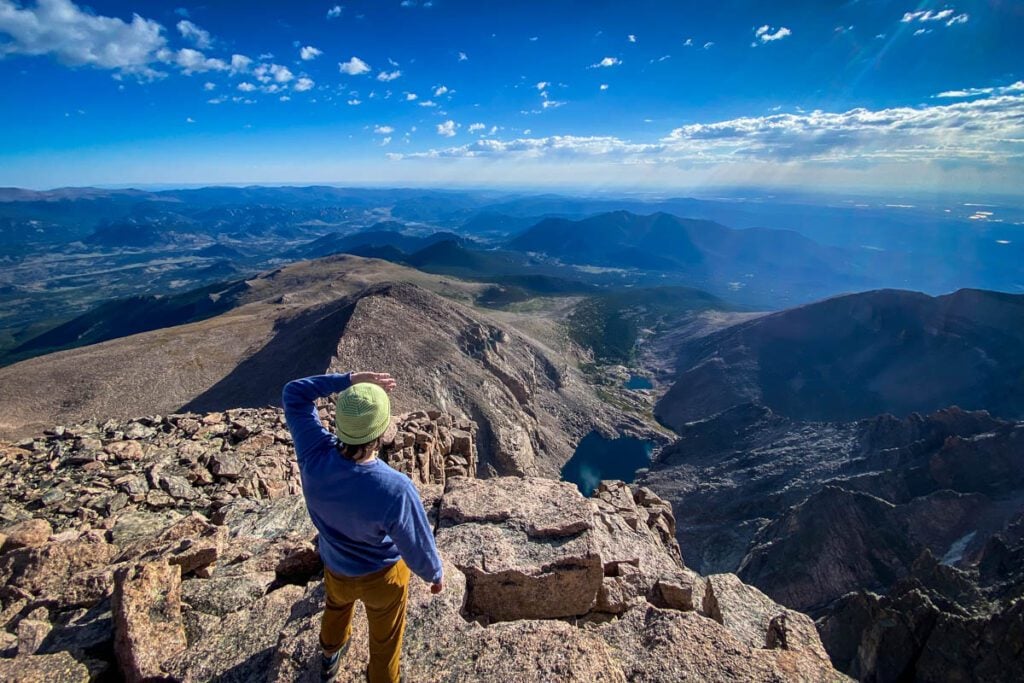
- Distance: 13.3 miles, out and back
- Elevation gain: 4,960 feet
- Difficulty rating: Strenuous
- View the trail notes
At 14,259 feet tall, Longs Peak is arguably the centerpiece of the national park. The distinct-looking mountain is visible from all over the park. It can even be seen from Denver!
Summiting Longs Peak is one of the most grueling but rewarding things to do in Rocky Mountain National Park.
Most people reach the summit via the famous Keyhole Route. This route is exposed, sees massive drop-offs, and requires scrambling up rocks. While it doesn’t require technical climbing expertise, it does require a high level of fitness. It’s much more challenging than your average hike.
All that said, it is an unforgettable experience.
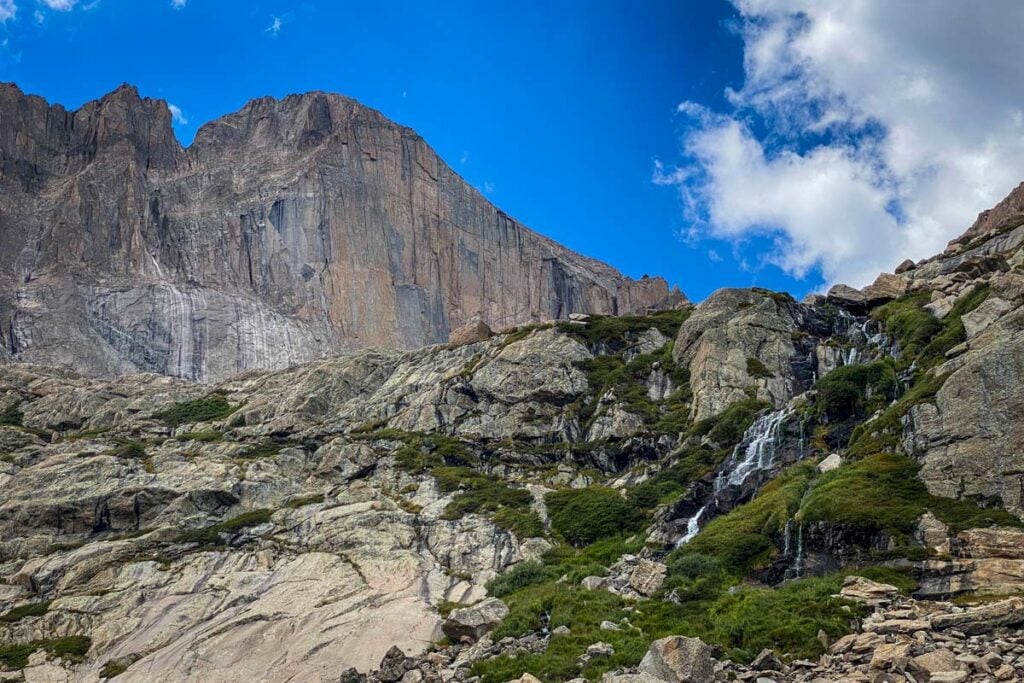
Take note of the following tips before embarking on the trip:
- Start early. Most people who summit Longs Peak depart from the trailhead by 3 AM, sometimes earlier!
- Be prepared for changing weather. If you see signs of thunderstorms, turn around!
- Bring at least 3-4 liters of water and plenty of hiking snacks.
- Bring ample sun protection, since UV rays are more intense at high elevation.
- Most of the hike lies above 10,000 feet in elevation, where oxygen is low. Be sure you are acclimated to the elevation of the area before taking on the hike.
During the trek to Longs Peak, be sure to watch the sunrise! And make sure to take the detour to Chasm Lake – which adds 1.4 miles – if you’re feeling up for it on the way back. Chasm Lake is an incredible hike by its own merits, so it’s definitely worth a stop.
Read more about summiting Longs Peak and my experiences visiting Rocky Mountain National Park.
5. Spot wildlife
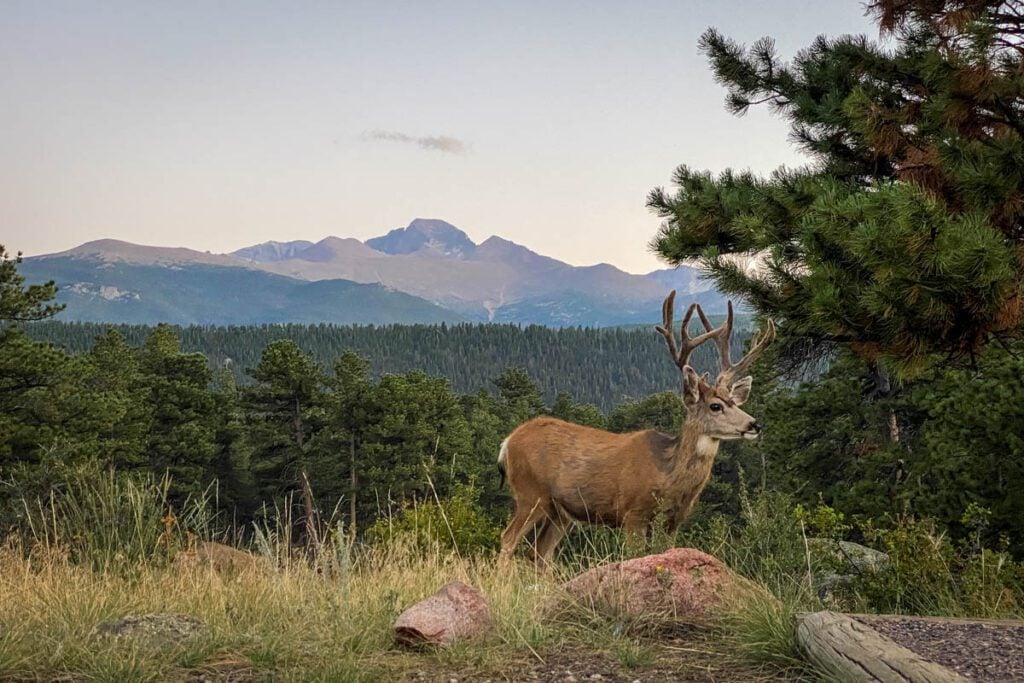
Rocky Mountain National Park is filled with diverse wildlife. At lower elevations, elk, mule deer, squirrels, and wild turkeys are common. Bighorn sheep, marmots, and pikas can be found at higher elevations. You might even spot a bear, moose, or mountain lion in the park.
Elk can be found frequently in the park. It’s not uncommon to encounter an elk while walking on a trail in the park. They are most active around dawn and dusk. Herds of elk often wander around the Moraine Park and Bear Lake areas.
Bighorn sheep can be found at Sheep Lakes (it’s in the name!) from May through August. Moose are most common in the Kawuneeche Valley area in the park’s west side.
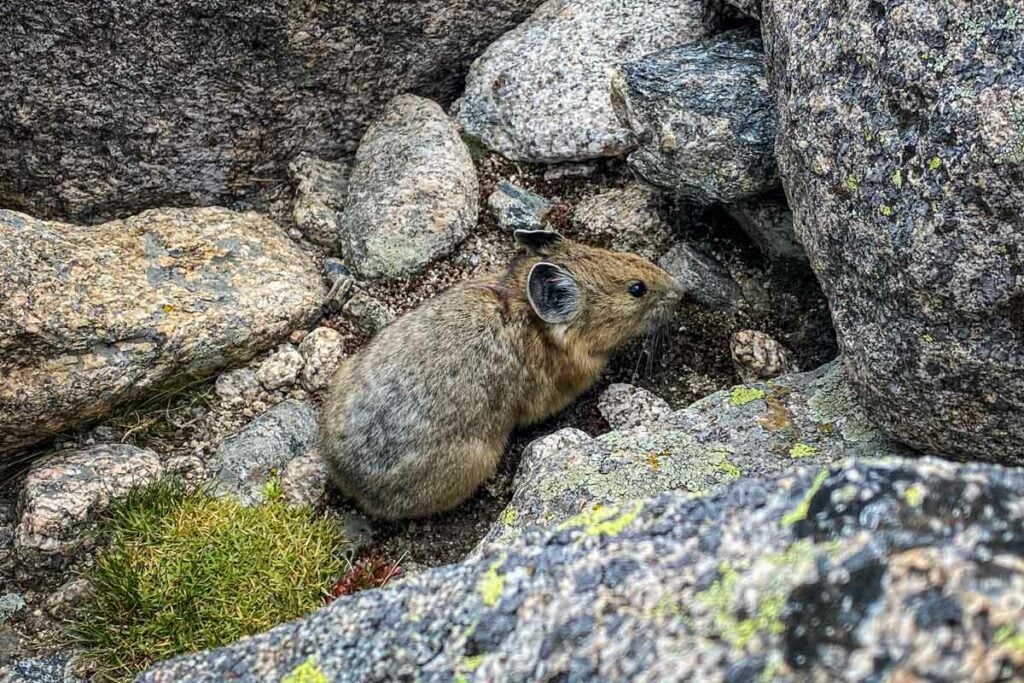
Pikas are one of the cutest animals in the park. They are small, speedy, and known for making a distinct chirping sound. They are common in many western national parks, but only are found at high elevations. The best place to see them running around is around exposed, rocky parts of trails.
Always keep your distance from wildlife! And never, EVER feed wildlife! You are endangering yourself and them whenever you fail to respect them and their habitat.
6. Swim in an alpine lake
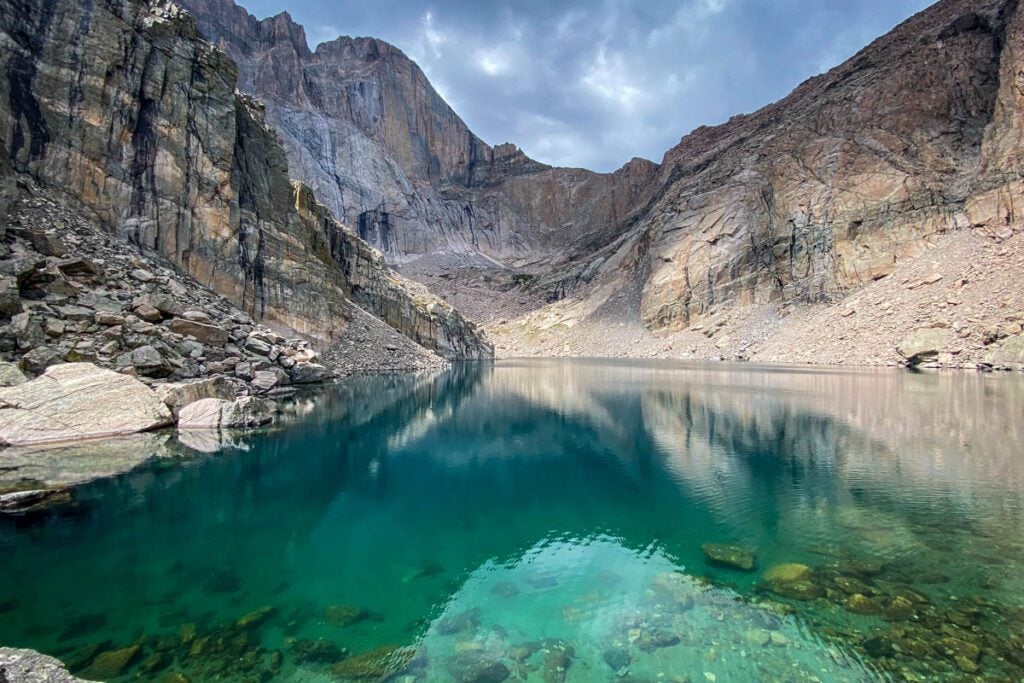
Have you ever gotten to the end of a long hike – hot, sweaty, and dirty – and craved nothing more than to soak in some cold water? Well, in Rocky Mountain National Park, you can do that on almost every hike!
Many of the park’s most popular trails pass or end at crystal-clear alpine lakes. There are nearly 150 lakes in the park, so you’d be remiss not to take a swim in one.
Don’t expect to spend very long in any of the lakes, since they are cold. Bring a towel, too!
Here are some of my favorite lakes to swim in at Rocky Mountain National Park:
7. Climb some rocks
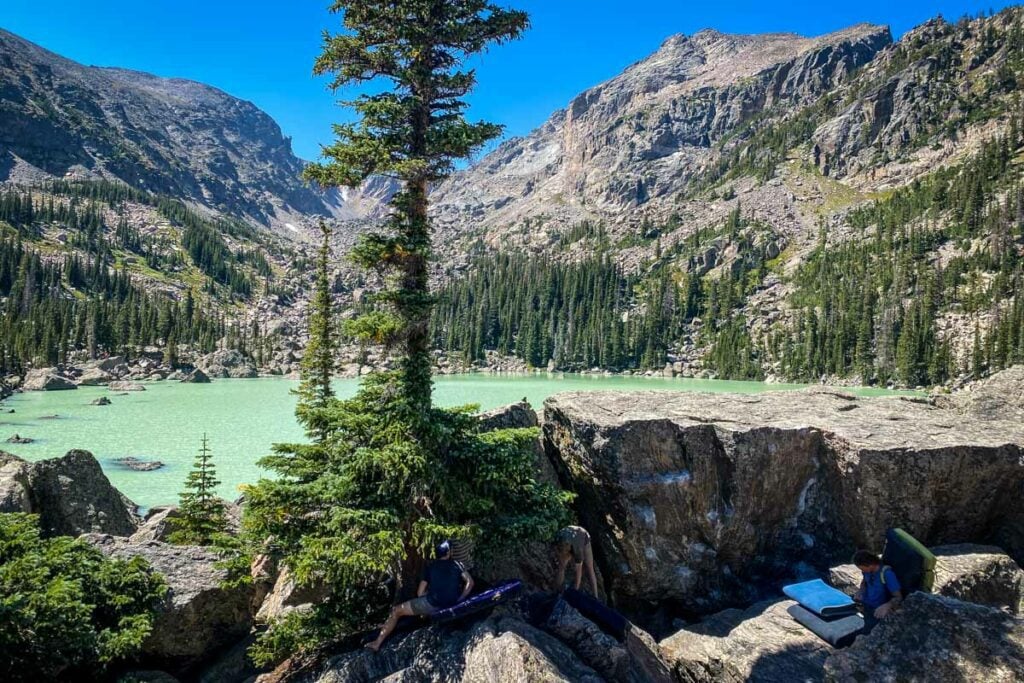
It may come as no surprise that Rocky Mountain National Park is a premier rock climbing destination. The park features a variety of quality bouldering, trad, and even sport routes.
Important note: While incredibly fun and challenging, rock climbing requires gear, experience, fitness, and planning to be done safely. Don’t attempt rock climbing without the proper background. Take the proper measures to keep yourself safe while engaging in this inherently dangerous activity.
Chaos Canyon – surrounding Lake Haiyaha – is a popular spot for bouldering. As the name implies, the chaotic layout of boulders in the canyon can make it hard to navigate. Be sure to bring a climbing guidebook or come with someone familiar with the area. Bring as many crash pads as you can carry.
Additionally, the Diamond on Longs Peak is a massive 2000-foot rock face. It features a number of world-famous routes that lead to the summit of the 14er.
Those with trad and alpine climbing experience will find days to weeks of climbing adventures here. Only attempt these climbs if you have the proper know-how, gear, and experience.
Several services in Estes Park offer guided climbing services. Visit Estes Park’s tourism page to learn more about these services.
If you’re not interested in technical climbing, no problem!
The park has plenty of areas with talus fields that are fun to scramble around. Chaos Canyon, Emerald Lake, Longs Peak’s boulder field, and Andrews Glacier all feature terrain with fun scrambles.
8. Hike along the Continental Divide
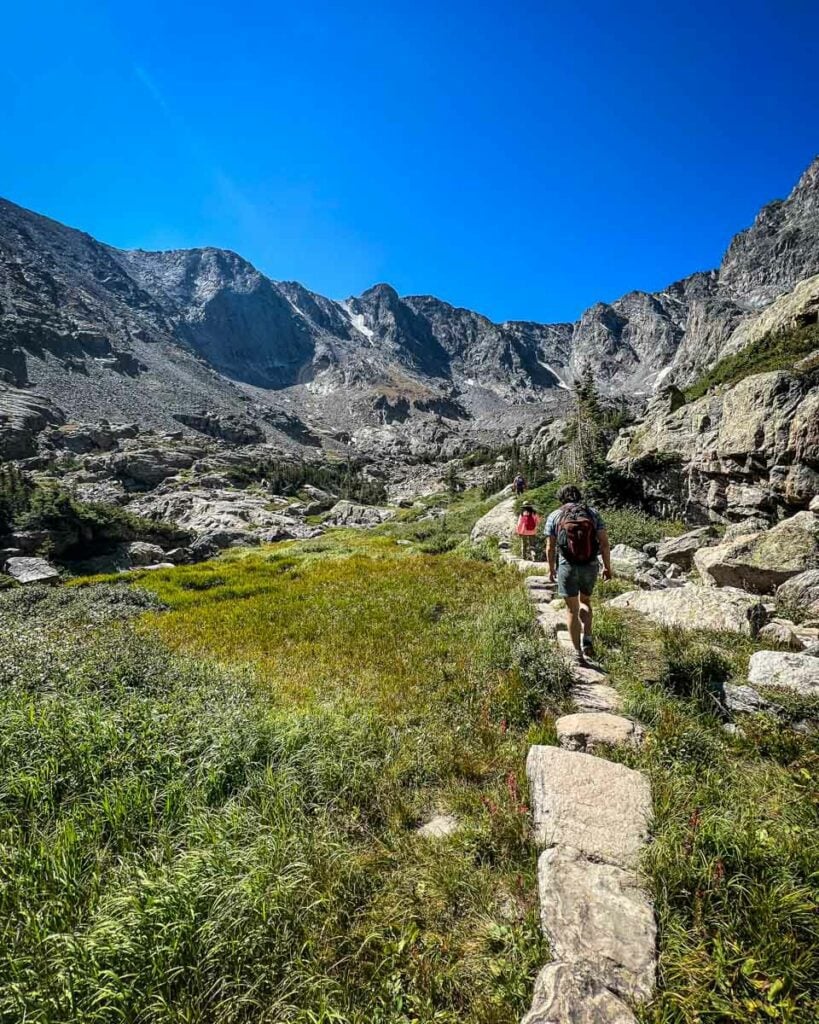
- Distance: 5.7 miles, out and back
- Elevation gain: 1,922 feet
- Difficulty rating: Moderate
- View the trail notes
The famous Continental Divide runs through Rocky Mountain National Park. To the east of the Divide, rivers flow into the Gulf of Mexico. To the west, they drain into the Pacific Ocean.
Trail Ridge Road crosses the Continental Divide, where the Ute Trail can be accessed. The Ute Trail begins at Poudre Lake and finishes at the Alpine Visitor Center, crossing the Divide. The trail is an 8-mile round trip journey.
You can also reach the Continental Divide via the stunning Flattop Mountain hike. If you’re feeling adventurous, you can backpack a portion of the Continental Divide National Scenic Trail, which covers much of the park’s southwestern section.
9. Camp in the park
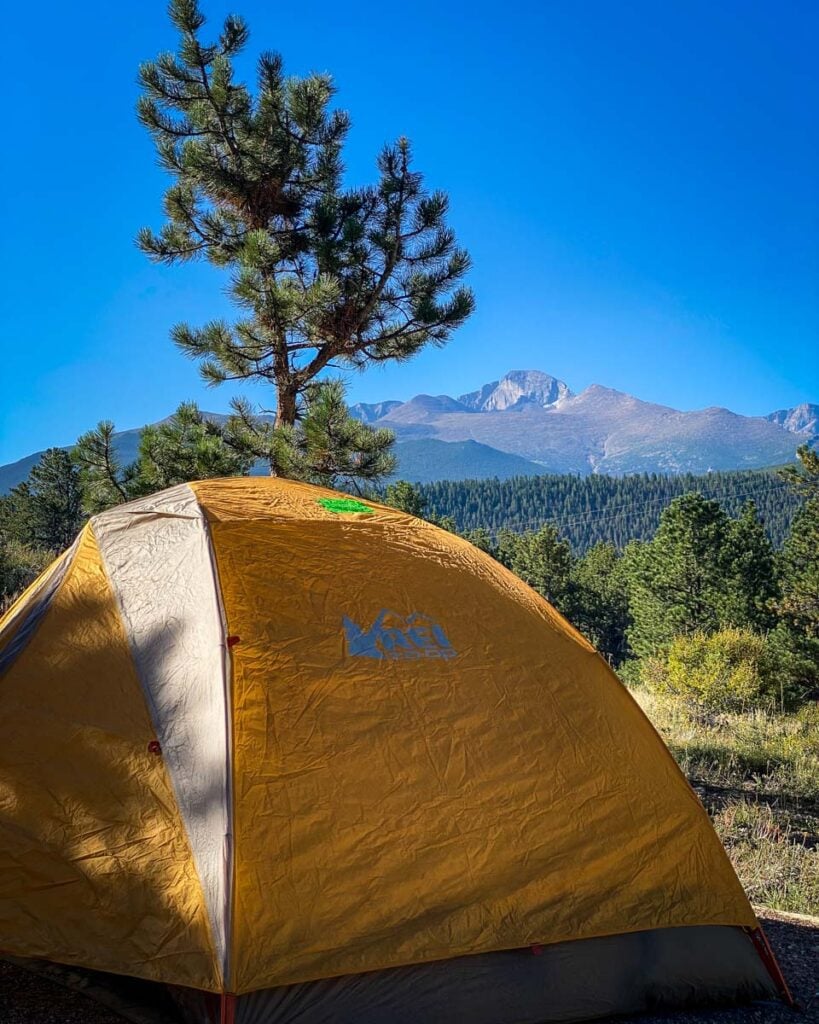
Camping is one of the best ways to maximize your time in the park. When you camp, you’ll never have to leave the park during your stay! This also means that you get to sleep under the stars and listen to nighttime wildlife around you.
Rocky Mountain National Park features several developed campgrounds. Many of these campgrounds offer incredible views of park scenery.
The best part? You get to enjoy that scenery at dawn and dusk – when the sun casts brilliant colors and shadows around the park – from the comfort of your own campsite.
Jump down to the where to stay section for a list of campgrounds in the park for more information about camping. If you plan to camp in the park, reserve a campsite far in advance. Campsites can be fully booked shortly after they become available.
Tip: Having a campground reservation means you don’t need a timed entry permit to enter Rocky Mountain National Park. This means you can enter and leave the park during the duration of your camping reservation without restrictions. Timber Creek Campground is the only reservable campground that is an exception: camping here allows unrestricted access to all parts of the park except the Bear Lake Road Corridor. (You will still need to reserve and purchase a Timed Entry + permit if you want to go there.)
10. Watch a sunrise or sunset
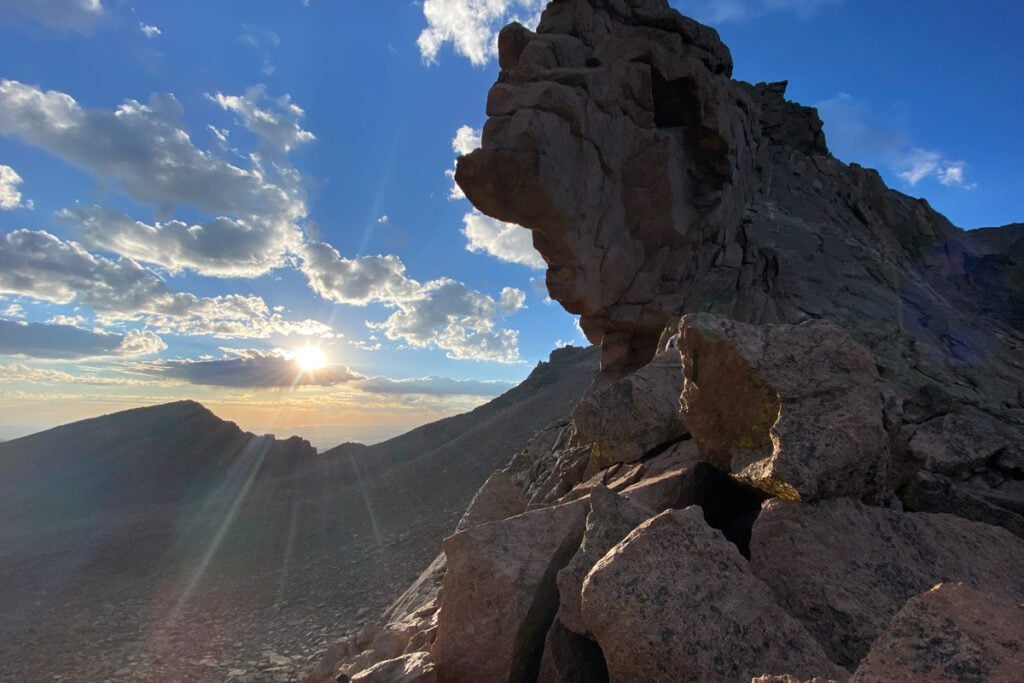
Rocky Mountain National Park offers some of the most beautiful scenery in the country. That scenery looks even more impressive during golden hour.
So, catching a sunrise or sunset during your visit to the park is a must. Try to get up early to catch a sunrise from the trail. Or, if you’re camping, set an alarm and sit at your campsite to watch the sun break the horizon.
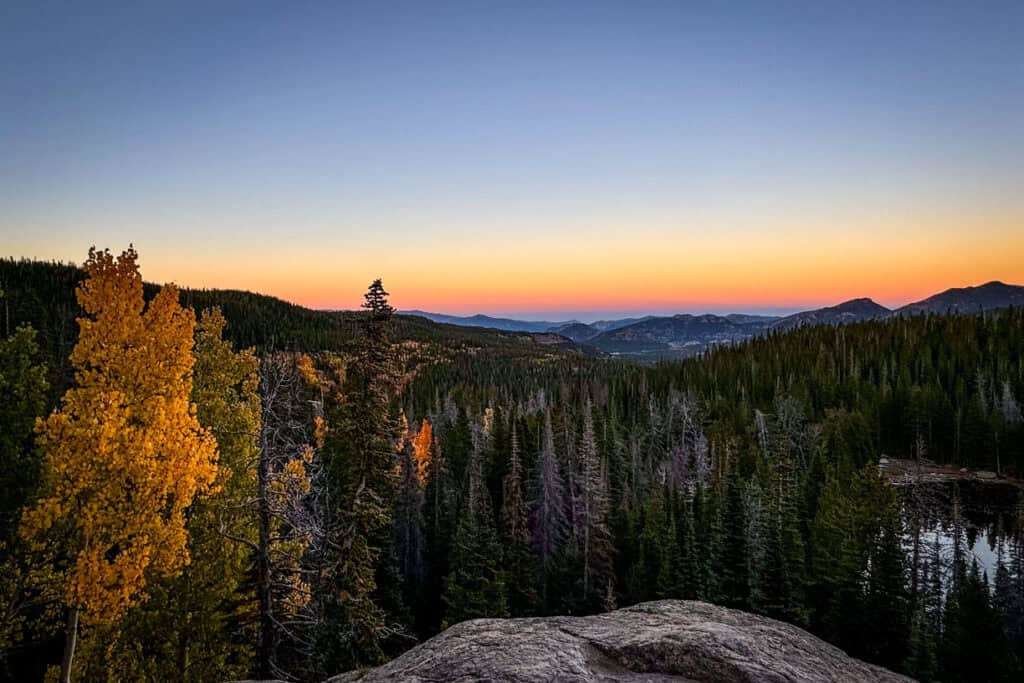
Sunsets are beautiful from almost anywhere in the park. Trail Ridge Road offers some excellent spots – like the Forest Canyon overlook or the Alpine Visitor Center – to watch the sunset.
If you’re up early to summit Longs Peak, be sure to take a break during your ascent to watch the sunrise. The Keyhole and the summit are both great places to catch the rising sun. You won’t want to miss it.
11. Go on a backpacking trip
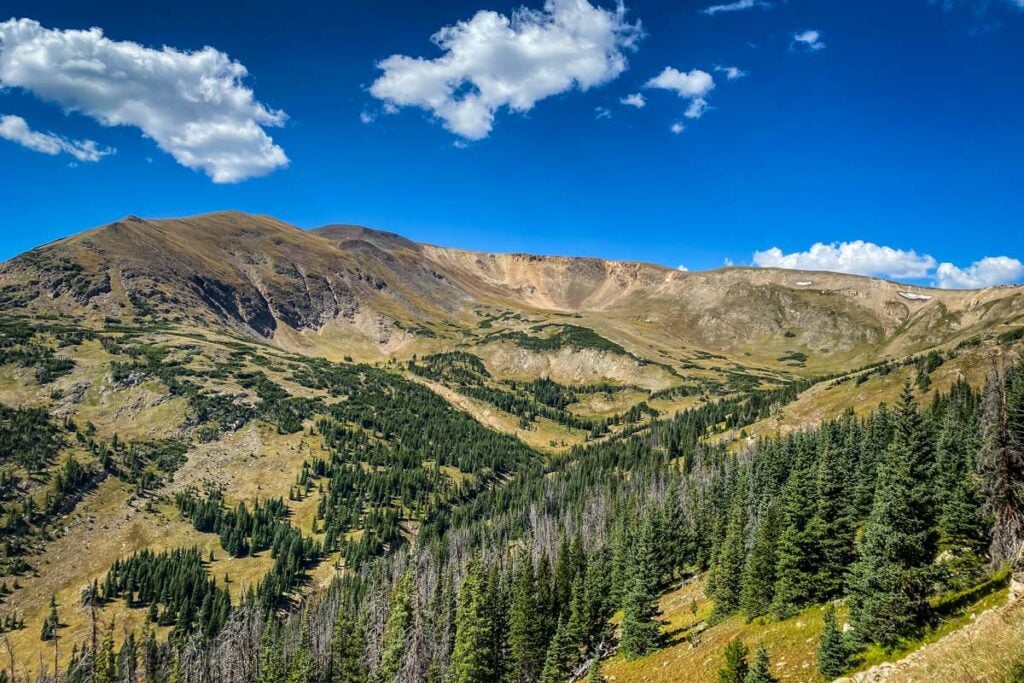
One of the best ways to escape the crowds at Rocky Mountain National Park is by donning your overnight backpack and hitting the trails. The park offers tons of trails to explore, giving you plenty of options for your trip.
Camping in the park’s backcountry requires a wilderness permit. The park limits stays at specific campsites to 3 nights, and quotas apply for individual sites.
Permits become available for reservation for the entire year on March 1. The park does not allow reservations in person, over the phone, by mail, or over email.
The National Park Service offers a useful backcountry map that shows all of the numbered backcountry campsites in the park. Be sure to visit the park’s FAQs on wilderness permits when planning your backpacking trip.
Important note: Backpacking requires proper gear and advanced planning in order to be done safely. Be mindful of your capabilities and experience levels and make sure you’re prepared before heading out. Read up on these tips for backpacking for beginners.
12. Hike all (or part) of the East Inlet Trail
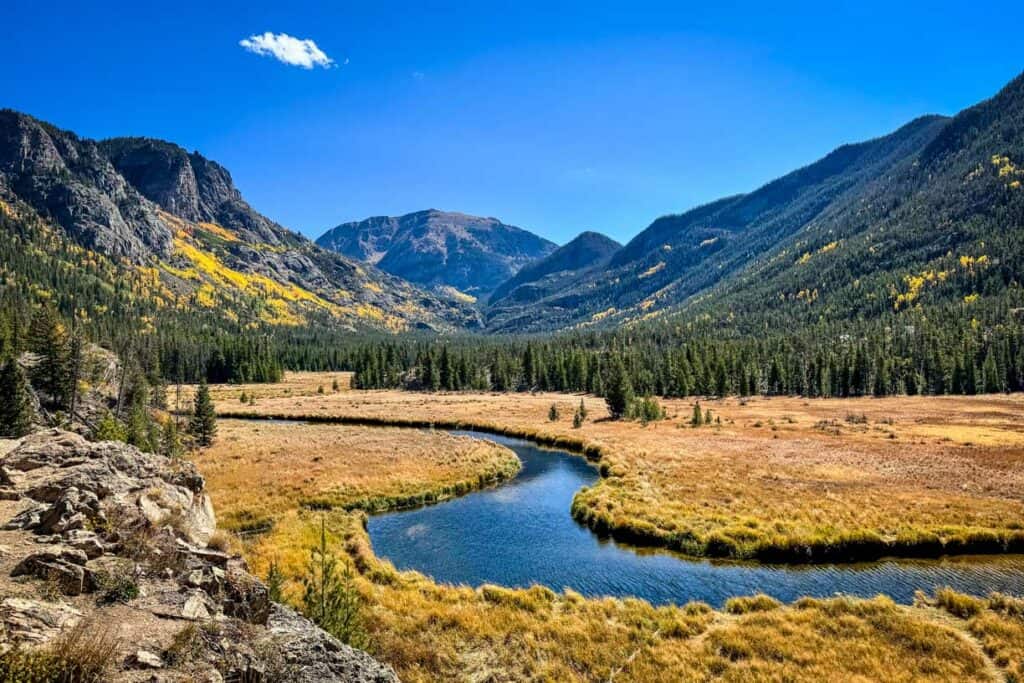
- Distance: 18 miles, out and back
- Elevation gain: 2,910 feet
- Difficulty rating: Hard
- View the trail notes
Don’t let that 18-mile distance scare you off! You don’t have to hike the entire trail to get some of the best views… In fact, if you only make it the first 2 miles out (plus 2 miles return), you’ll see some pretty incredible vistas.
If you want to take it easy, the first 2 miles on this leisurely trail are incredibly scenic with little elevation gain, making it a pretty easy endeavor for a big payout!
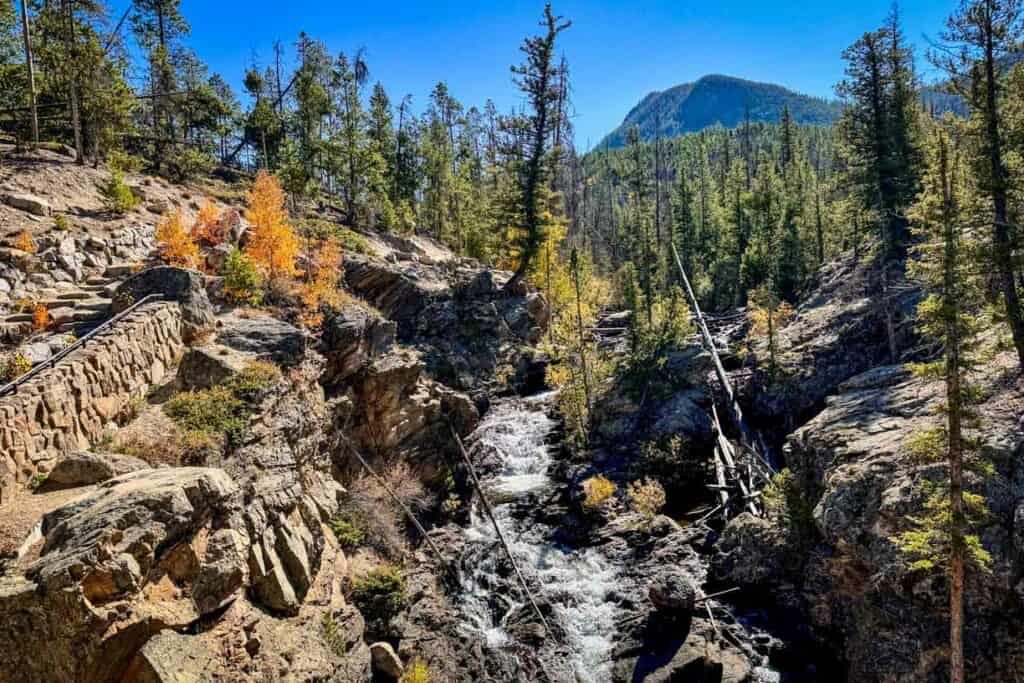
The first stop is Adams Falls, which is only about 10 minutes from the trailhead. Beyond the falls you’ll continue through patches of exposed and shaded trail alongside a beautiful meadow with scenic mountain vistas the entire way!
Your turn-around point (if you should choose) is another smaller waterfall, right at about the 2-mile mark on the trail.
And afterwards, you can check out the town of Grand Lake, since you’ll have to drive through it to get to the trailhead. We recommend grabbing a post-hike bite to eat at One Love Rum Kitchen, their fish tacos and jalapeño margs are delish!
13. Tour the park on a bike

Rocky Mountain National Park’s scenic, well-paved roads beckon cyclists to go for a spin! Leisurely bike rides can be found around Estes Park and at lower elevations in the park.
If you’re an advanced cyclist, consider a longer, more challenging ride. Trail Ridge Road in particular is just as beautiful to see from a bike as from a car. Its windy switchbacks and elevation changes make for a riveting ride.
Cyclists have to share the road with cars, and roads are often narrow. Ride with care, and start your rides early in the morning to avoid congested roads.
Several outlets in Estes Park offer bike rentals, including road bikes, mountain bikes, and e-bikes. Mountain biking is not allowed on trails in Rocky Mountain National Park, but Old Fall River Road’s gravel terrain is perfect for those looking to take a mountain bike for a ride.
Note: If you enter the park on a bike, you still have to pay an entrance fee. It costs $15 for a 1-day, 1-person pass to the park.
14. Have some fun in Estes Park
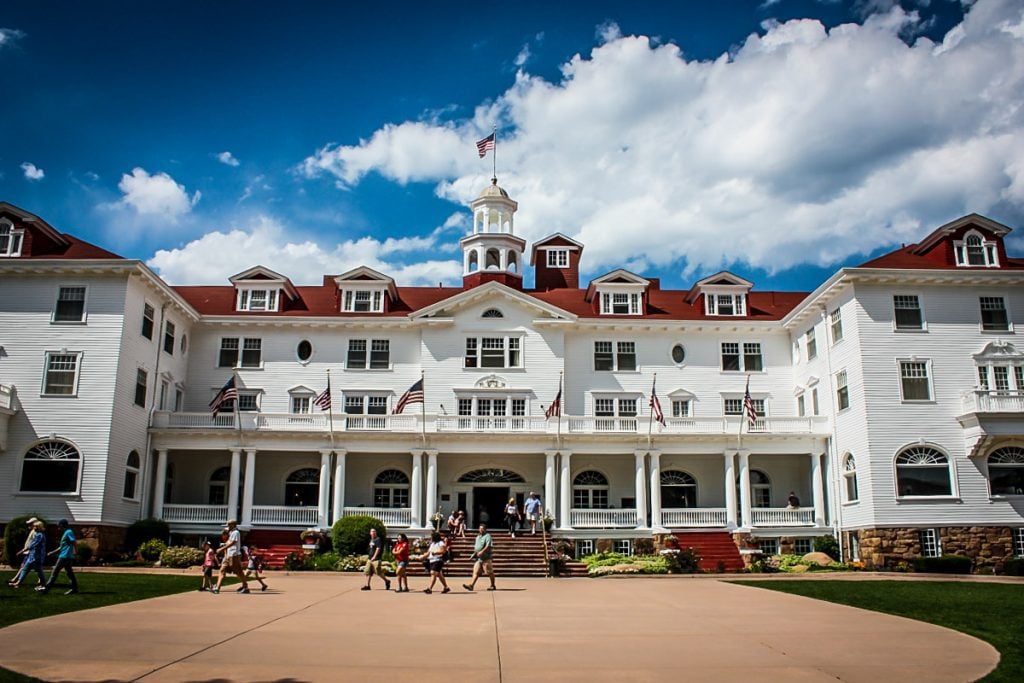
If you’re visiting Rocky Mountain National Park, you’re likely there for the natural beauty, hikes, camping, and wildlife. But, who says you need to be limited to just inside the park?
Estes Park is a resort town that sits just east of the national park. Many visitors to RMNP stay in the town in one of its many hotels or Airbnbs.
Many guided tour services call the town “home”, as do countless restaurants and bars. Local cuisine can satisfy almost any craving, and microbreweries dot the town for those looking to indulge in Colorado’s famous craft beer scene.
The town hosts live music and other events throughout the year, especially during the national park’s busy summer season.
All that being said: Estes Park is a great place to kick back after spending time in the national park. While you’re there, consider the following activities:
- Visit the Stanley Hotel, the spooky hotel that helped inspire The Shining
- Go kayaking on Lake Estes
- Walk around Estes Park and go shopping
- Walk along the Big Thompson River
- Go whitewater rafting!
Psst! Don’t leave before you check out our bucket list of seriously fun things to do in Denver.
15. Summit a 13er
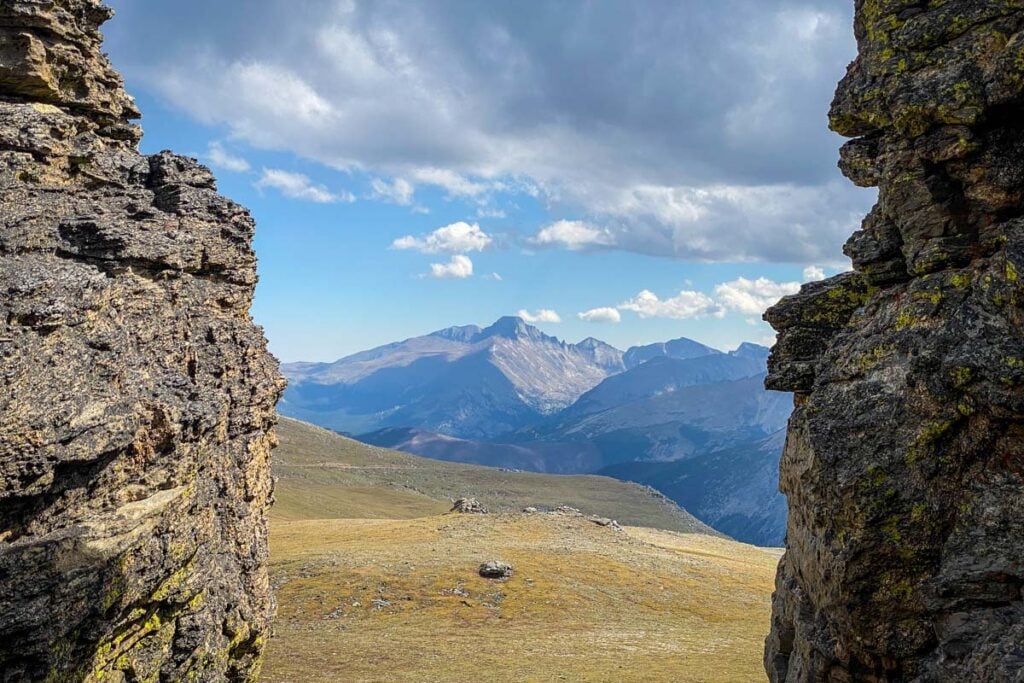
As the park’s only 14er, Longs Peak typically gets most of the attention from peak baggers at Rocky Mountain National Park. It’s an incredible hike, but crowds on the peak and on the trail can detract from the experience…
If you want high-altitude adventure but don’t want to deal with crowds, consider summiting a 13er instead! The park is home to 20 mountains with elevations over 13,000 feet. Several of these 13ers surround Longs Peak, making them easy to access.
Hikes to the following 13ers leave from the Longs Peak trailhead:
- Mount Lady Washington (13,245 feet, 7.9 miles rd trip, 3,871 ft elev gain)
- Storm Pass (13,326 feet, 14.4 miles rd trip, 3,238 ft elev gain)
- Mount Meeker (13,911 feet, 13.2 miles rd trip, 5,052 ft elev gain)
You can also find a cluster of 13ers in the Mummy Range, in the northern part of the park. This part of RMNP sees way less visitors than the rest of the park, offering peaceful solitude to the few adventurers that travel there.
The hikes in this area are long but rewarding. If you’re able to summit Longs Peak, you’ll also be able to tackle these isolated peaks. These hikes leave from the Lawn Lake trailhead:
- Mummy Mountain (13,425 feet, 14.7 miles rd trip, 4,911 ft elev gain)
- Fairchild Mountain (13,502 feet, 20.5 miles rd trip, 5,160 ft elev gain)
Plan for any and all of these hikes like you would for Longs Peak. Bring 3-4 liters of water, plenty of snacks, and sun protection. Start early so that you are below the treeline by early afternoon. If you see signs of rain or thunder, turn around!
16. Explore the park in the snow
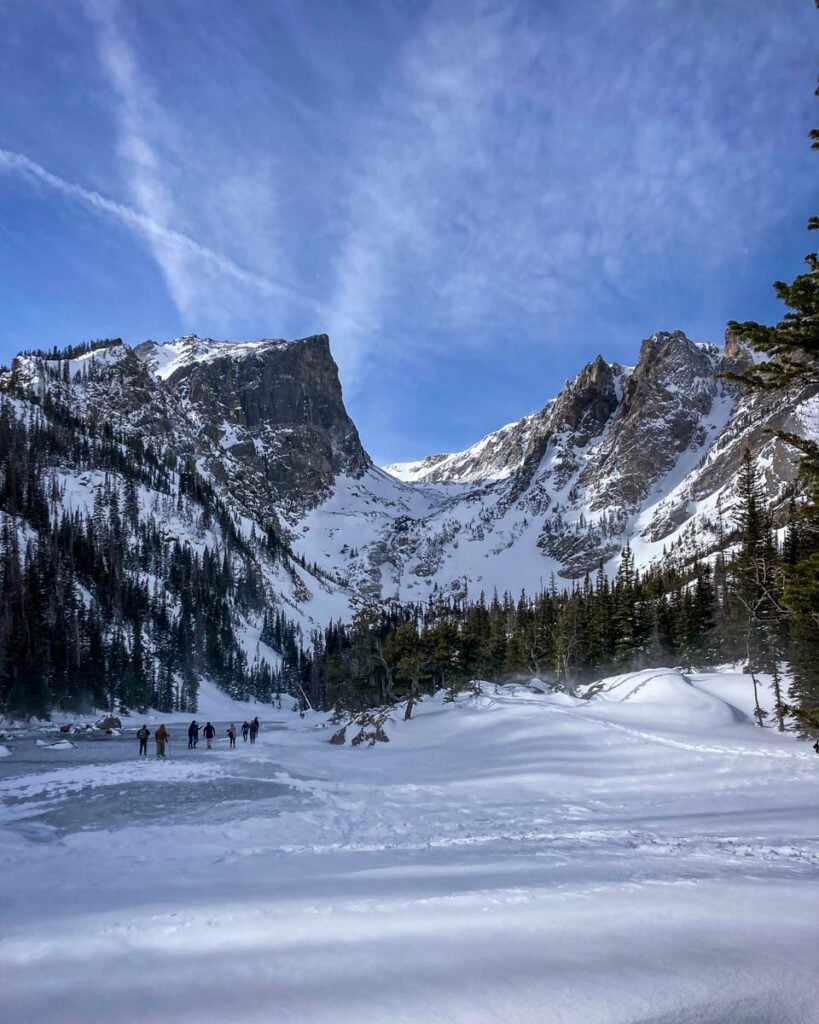
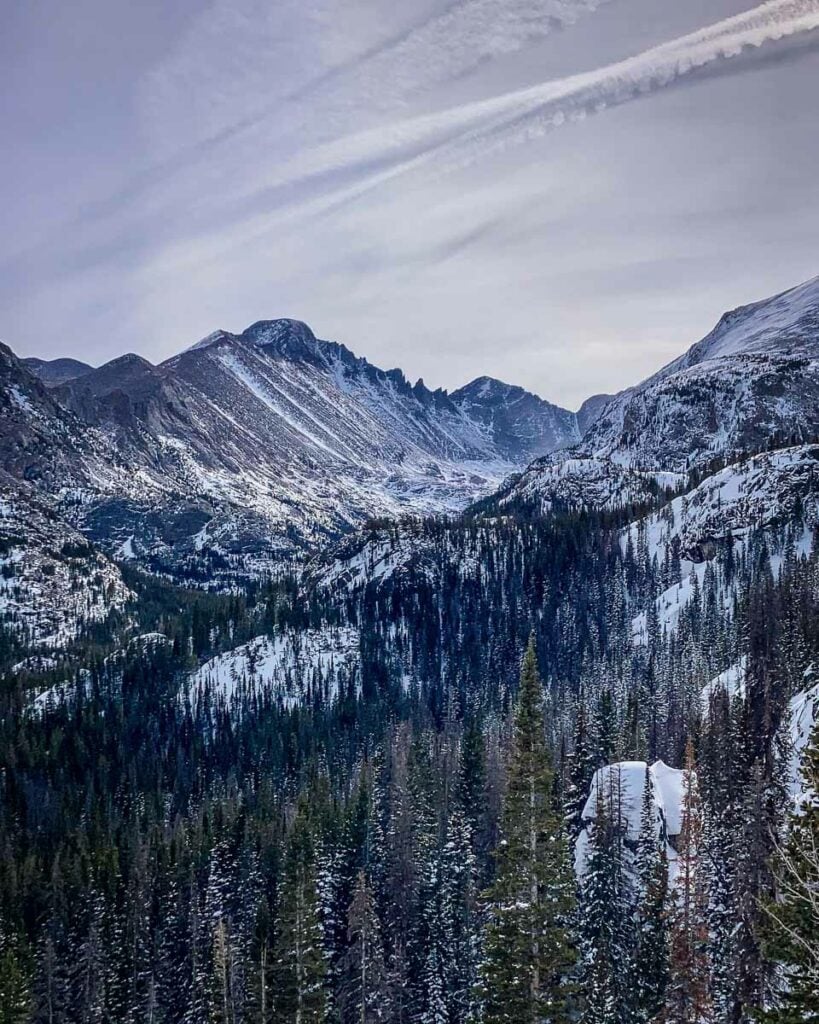
There are the most things to do in Rocky Mountain National Park in the summer. In winter, many of the park facilities, shuttles, and roads are closed. Still, RMNP offers lots to do in the winter!
It is also a beautiful time of solitude in the park.
You can hike many of the park’s hiking trails with snowshoes or microspikes. Both devices are easy to strap to your hiking boots.
So, if you’re a competent hiker, you’ll have no issues trudging along the park’s trails in the snow with the proper traction devices. A pair of trekking poles can help you maintain balance in the snow, too.
Cross-country skiing is another popular activity at RMNP in winter. You can explore the park’s hiking trails with a good pair of skis in winter.
Check out the park’s winter hiking guide.
Also, did you know that you can sled at Rocky Mountain National Park?
Hidden Valley – in the Horseshoe Park area – is the only place in the park that allows sledding in the winter. So, if you’re interested in some fun winter shenanigans with awesome views, bring your sled to RMNP in the winter!
17. Hike a trail less traveled
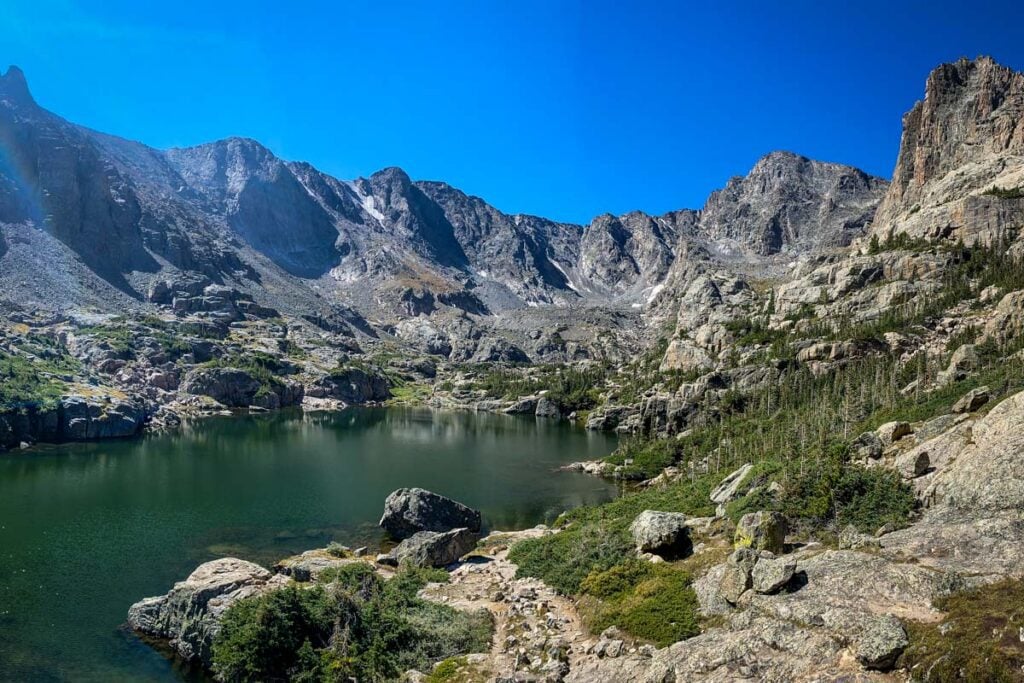
There are over 350 miles of trails in Rocky Mountain National Park. The park’s most popular trails only account for a small fraction of that mileage.
If you have visited RMNP before, or are spending more than 4-5 days in the park, consider taking a hike on the park’s more remote trails. You may not find the views that people on social media think are most impressive, but you’ll find something special that you and only a few others can truly appreciate.
To hike a trail less traveled, look in the following areas of the park:
- Wild Basin
- Kawuneeche Valley
- Lawn Lake Trailhead
- Cub Lake Trailhead
- Lumpy Ridge Trailhead
How to get to Rocky Mountain National Park
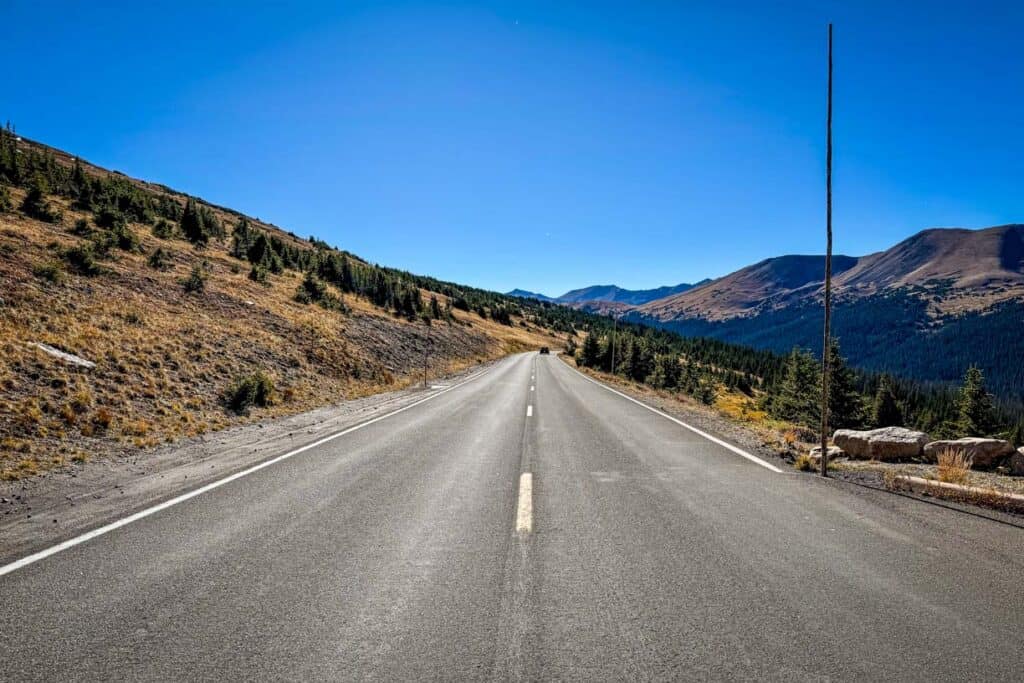
Rocky Mountain National Park resides in north-central Colorado. The closest airport to the park is Denver International Airport, which is about 1.5 hours driving distance from the park’s entrance. This makes the park one of the best day trips from Denver.
A commercial shuttle service offers transportation from Denver International Airport to Estes Park, the resort town that sits just outside Rocky Mountain National Park.
Driving to Rocky Mountain National Park
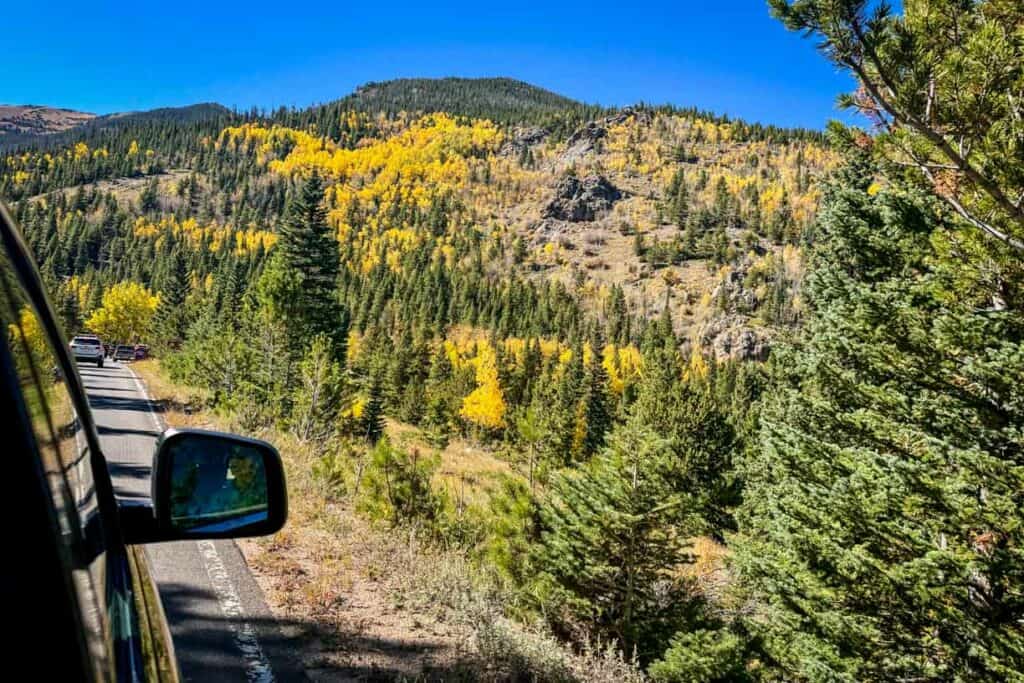
Rocky Mountain National Park is easily accessible by road, a characteristic that contributes to the park’s popularity. Here are the most common ways to reach the park by car:
- Highway 36 Westbound: From Denver, the most direct way into Rocky Mountain National Park is by using US Highway 36. The highway heads north from the downtown area, taking you past Boulder to Estes Park and RMNP’s east entrance. If visiting Longs Peak, you’ll likely turn left from Hwy 36 onto CO-7 in Lyons.
- Highway 40 Eastbound: If you’re visiting RMNP as part of a national park road trip, you may be approaching from the west. In this case, you will take I-70 until exiting onto US Highway 40, which will take you north towards Winter Park. Hwy 40 takes you past Winter Park and eventually intersects with US 36 East, which leads into RMNP’s west entrance.
Note: The road that connects the park’s east and west sides is impassable in winter and spring. So, pick your entrance to the park wisely during this time.
Shuttle to Rocky Mountain National Park
If you are flying into the Denver airport but don’t want to rent a car to visit Rocky Mountain National Park. No problem! Estes Park Shuttle offers a shuttle service that takes you from the airport to Estes Park.
Visit the Estes Park Shuttle website to learn more about their shuttle service and other pick up points around Denver.
Getting around in Rocky Mountain National Park
Navigating Rocky Mountain National Park is possible through several methods. Shuttles operate in the park and the park roads are accessible by both cars and cyclists.
Driving in Rocky Mountain National Park
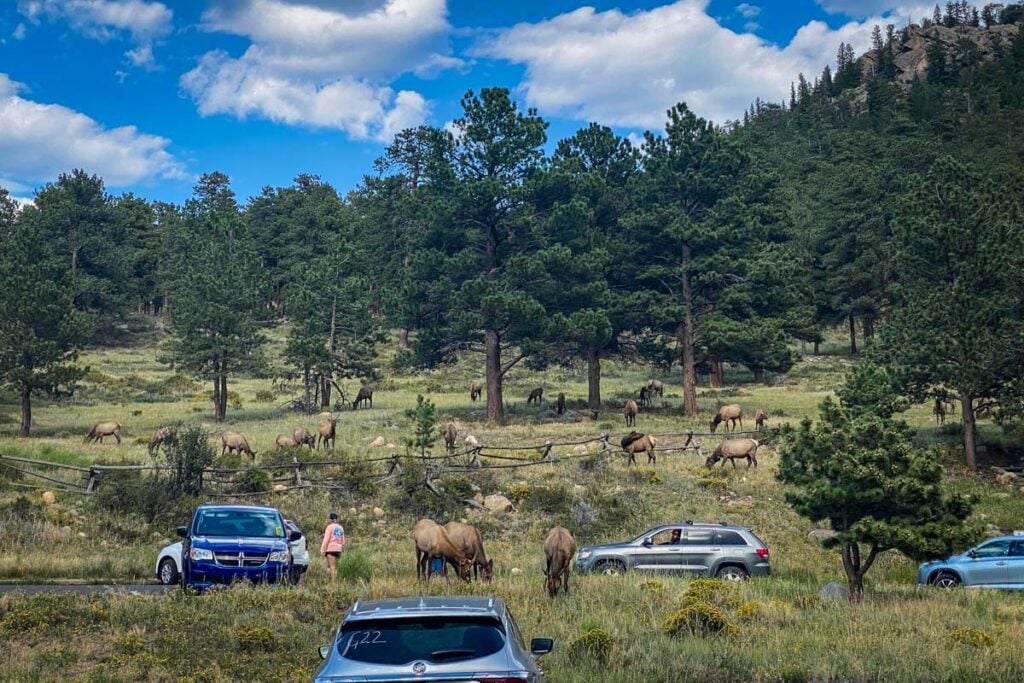
The easiest way to navigate Rocky Mountain National Park is by car. Paved roads take you to all of the park’s most popular areas. Scroll down to read more about the areas in the park.
Trail Ridge Road connects the park’s east and west sides, but is closed in winter and spring. The scenic drive is something you have to check out during your visit. We’ll talk more about this road and its must-do stops later.
Shuttles in Rocky Mountain National Park
If you don’t want to drive to the things to do in Rocky Mountain National Park, don’t sweat. The park features a network of shuttle services that operate during peak season. During the busiest times, you might need to use the shuttle service to access the park’s most popular areas. Let’s break these shuttles down…
- Hiker Shuttle: This paid shuttle service brings hikers from Estes Park to the Park & Ride. At the Park & Ride, you can take free shuttles that take you to destinations in Moraine Park and Bear Lake Road Corridor (detailed below). The Hiker Shuttle costs $2 per hiker to ride. You need to reserve spots on this shuttle in advance.
- Moraine Park Shuttle: This free shuttle brings visitors to destinations in Moraine Park. Destinations include the campground and several trailheads. This shuttle stops at the Park & Ride lot.
- Bear Lake Road Shuttle: This free shuttle brings visitors to three trailheads in the Bear Lake area. Unless you get a crazy-early start during the busy season, you will have to use this shuttle to access the Bear Lake area. The Bear Lake parking lots fill up fast during the busy season. So, prepare to park at the Park & Ride lot to utilize this shuttle.
The Park & Ride lot is essentially a massive parking lot where shuttles can pick up hikers. During the park’s busy season (May-October), the Park & Ride can be very useful. Parking in popular areas – especially trailhead lots along Bear Lake Road – can be tricky as lots fill up quickly during this time.
Get more information about RMNP’s shuttle services.
Psst! Katie & Ben here….
Wanna try out vanlife while visiting Rocky Mountain National Park?
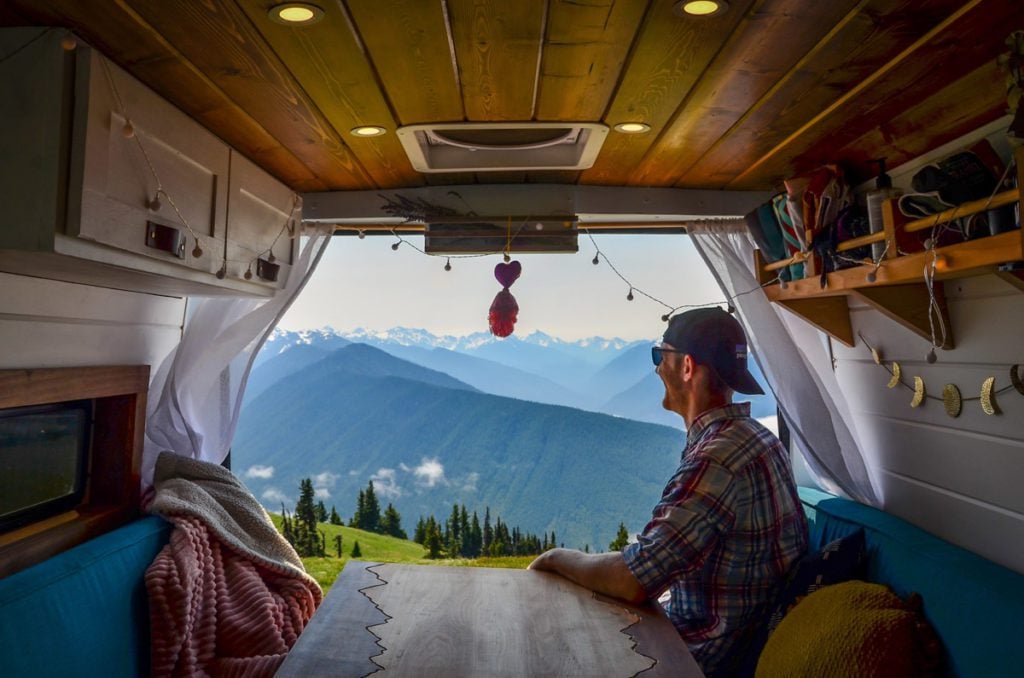
It’s no secret we’re obsessed with #vanlife. However, if you don’t have the time (or interest!) in building your own conversion but you still want to give vanlife a test drive, we’ve got options for you…
Check out our list of top companies for USA Campervan Rentals, from budget to bougie, we’ve even included some exclusive discounts for our readers!
One company we’d recommend looking into is Escape Campervans. They have 12 different locations across North America and come fully loaded with all the gear you need for an epic road trip. Plus, their rates are fair and affordable.
BONUS: We’ve partnered with them to give you a 10% off discount when you use our link!
We have plenty of recommendations for campervan-friendly campsites in the where to stay section below.
Areas of Rocky Mountain National Park
Rocky Mountain National Park is a large place with a number of distinct areas. Let’s break down those areas to understand the layout of the park:
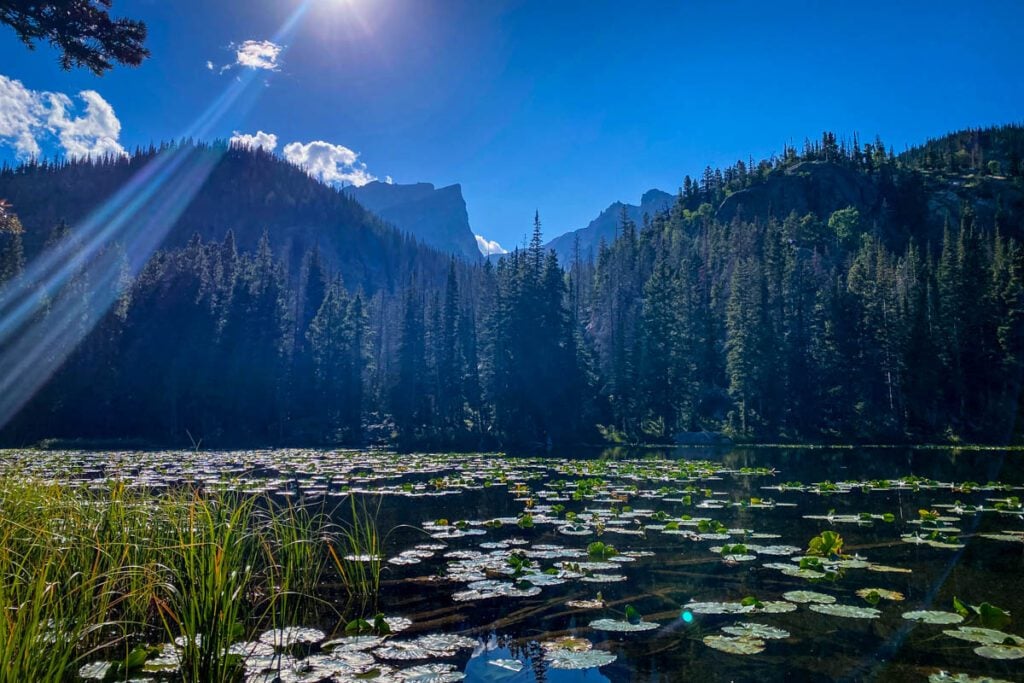
- Bear Lake: If you’re visiting RMNP for the first time, you’ll likely spend most of your time here. Bear Lake is in the park’s east-central portion, not far from Estes Park. This area features a large concentration of popular hikes and beautiful lakes. You’ll also find great views of Longs Peak here. Unsurprisingly, this area is typically very busy, and parking lots here fill up quickly during peak season. This area includes the Glacier Gorge trailhead, Glacier Basin, and Bierstadt Lake.
- Moraine Park: One of the park’s best campgrounds and several lesser-traveled hikes are found in this area. Moraine Park is located inside the park just west of Estes Park, on the way to the Bear Lake area. Wildlife encounters are common here, as herds of elk often wander through the area’s namesake meadow.
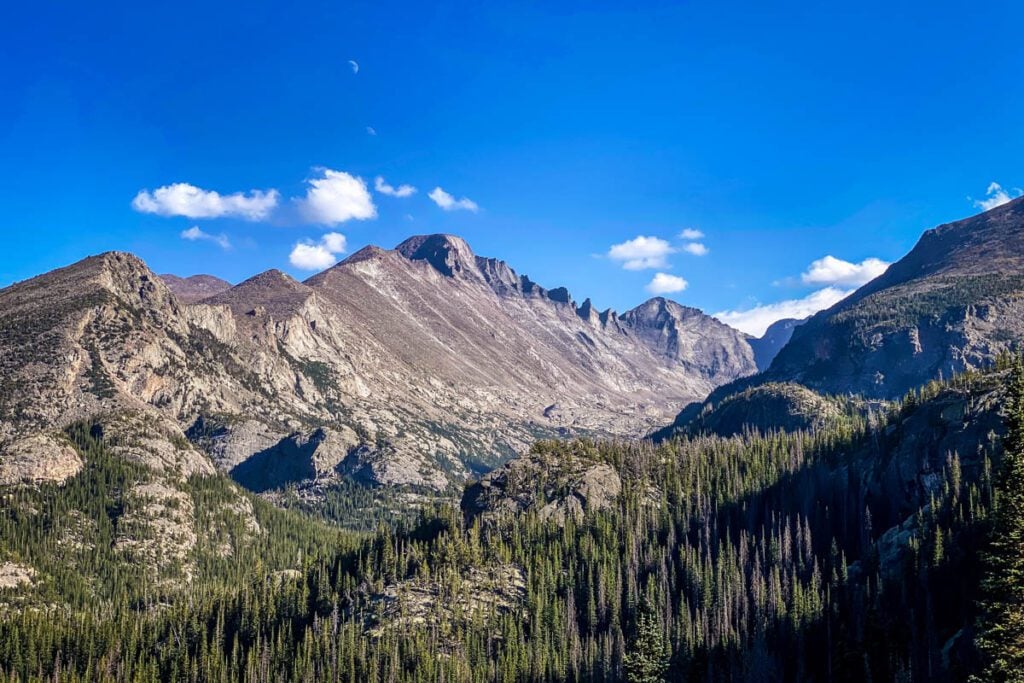
- Longs Peak Trailhead: This trailhead in the park’s southeastern corner provides access to a number of famous hikes in the park, most notably the Longs Peak summit and Chasm Lake. You can also reach several 13ers from this location.
- Lily Lake: Located on the road between Longs Peak and Estes Park, this lake offers leisurely walks with great views of the park. The Twin Sisters Peaks hike begins here.
- Horseshoe Park: Sitting north of Moraine Park, Horseshoe Park includes a few hiking destinations like Deer Mountain and Lawn Lake. Sheep Lakes – a popular spot to view wildlife – and access to Old Fall River Road are also found here.
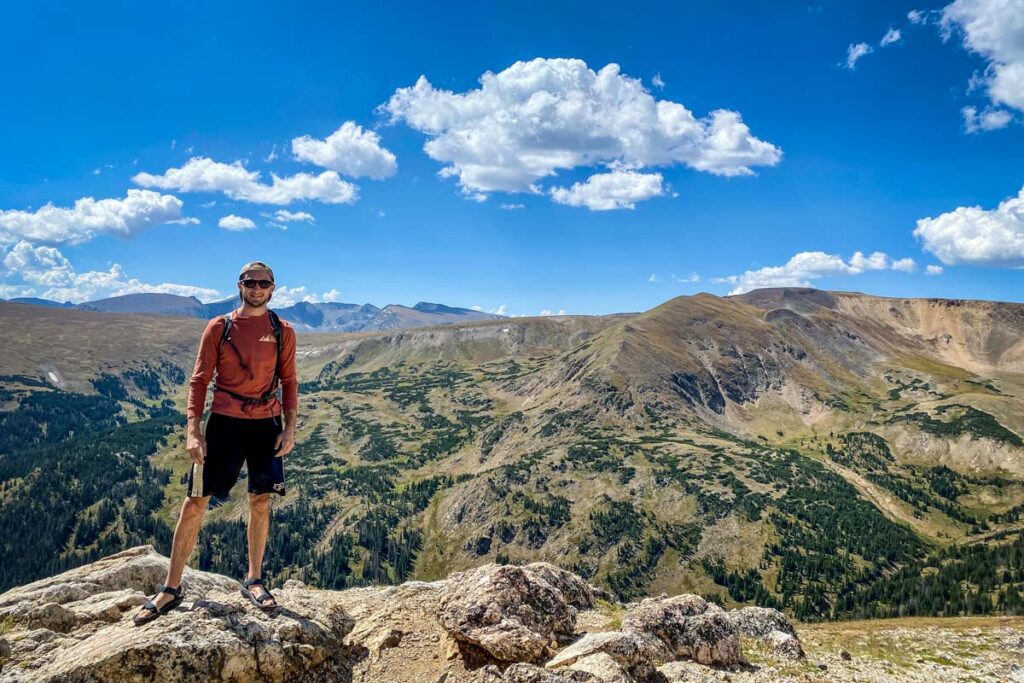
- Trail Ridge (the alpine tundra): Trail Ridge Road connects the park’s east and west sides, but its most interesting segment is in the high-elevation alpine tundra in the center of the park. Many short hikes, viewpoints, and the park’s Alpine Visitor Center are located here.
- Kawuneeche Valley (the west side): The park’s lesser visited west side is primarily encompassed by Kawuneeche Valley. You can find peace, solitude, and days’ worth of hikes in this area.
- The Continental Divide: The Continental Divide cuts right through the center of RMNP. Though a couple of short(ish) hikes provide access to the Divide, most of the Divide in the park is surrounded by wilderness. In these remote locations, you’ll find only the most fit and prepared adventurers.
- Wild Basin: As the name implies, this area of the park tends to see fewer visitors compared to other areas. Located about 5 miles south of Longs Peak, the trailhead here features several long hikes that guide hikers to secluded lakes in the mountains.
Rocky Mountain National Park map
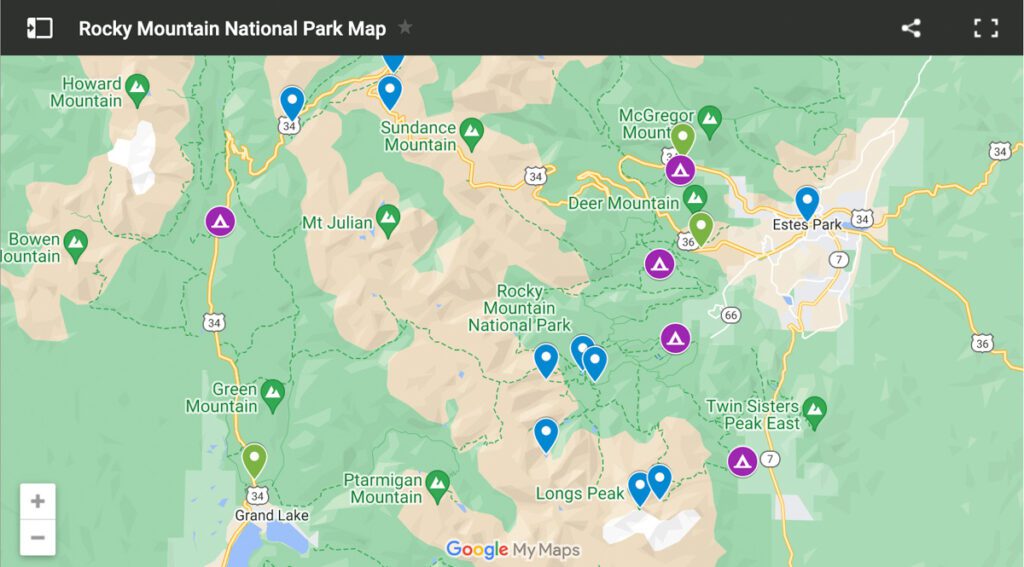
The map above displays the main entrances, campgrounds, lodging options, and locations for the best things to do in Rocky Mountain National Park.
Entrance tickets and fees
- Private vehicle: $30, valid for 1 day / $35, valid for 7 days
- Motorcycle: $25, valid for 1 day / $30, valid for 7 days
- Per person (including cyclists): $15, valid for 1 day
Timed entry permits for Rocky Mountain National Park
As one of the most popular and accessible national parks, it’s no surprise that Rocky Mountain National Park has implemented a timed entry permit system. These permits are meant to help prevent overcrowding in the park. The permit system is a little confusing, so read carefully…
Since 2021, Rocky Mountain National Park requires a timed entry permit during the busy season, from mid-May to mid-October (exact dates change each year). The permits give you a two-hour window to enter the park. The permits do not dictate your departure time. In other words, once you’re entered, you can stay as long as you like.
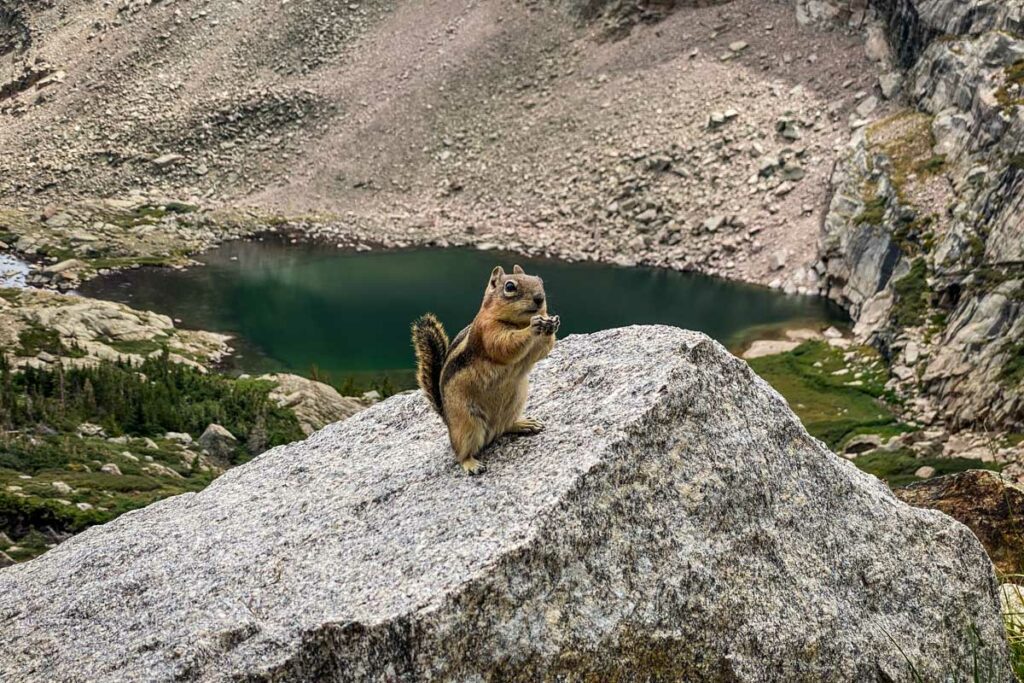
There are TWO timed entry permits:
Timed Entry
- Required to access Rocky Mountain National Park during busy season between the hours of 9 a.m. to 2 p.m.
- Outside of these hours, you do not need a timed entry ticket, and you can stay as long as you’d like.
- Access includes: Trail Ridge Road, Alpine Visitor Center, Old Fall River Road, the west side of RMNP, Wild Basin and any area of the park located outside of the Bear Lake Road Corridor.
- Must access the park within the designated 2 hour window on your permit. You can stay as long as you want after entrance, and re-entry is allowed with a valid reservation.
- Included with a valid camping reservation at Aspenglen, Glacier Basin, or Timber Creek Campgrounds. Entrance to the park begins at 1 p.m. on the first day of your camping reservation.
Timed Entry + Bear Lake Road
- Required to access Bear Lake Road in Rocky Mountain National Park during busy season between the hours of 5 a.m. to 6 p.m.
- Outside of these hours, you do not need a timed entry ticket, and you can stay as long as you’d like.
- Access includes: The entire national park, including Bear Lake Road Corridor, which encompasses Bear Lake, Emerald & Dream Lakes, Sprague Lake, Moraine Park, Glacier Gorge and more.
- Must access the park within the designated 2 hour window on your permit. You can stay as long as you want after entrance, and re-entry is only allowed after 2 p.m. with a valid reservation.
- Included with a valid camping reservation at only Aspenglen and Glacier Basin Campgrounds. Entrance to the park begins at 1 p.m. on the first day of your camping reservation.
- If you have a camping reservation at Timber Creek Campground and want to access the Bear Lake Road Corridor, you’ll have to purchase a separate Timed Entry + permit for the day(s) you are visiting.
Of the available permits, 60% are made available on the first day of the previous month. For example: on June 1, permits for the entire month of July become available.
The remaining 40% of available permits are made available at 7 p.m. local time (MST) the day before. For example, permits for July 3rd become available on July 2nd at 7 p.m. Mountain Time.
Confused? We know, we were, too. Read more about the park’s timed entry permit system to get the rest of the details.
Psst! Us again…
If you’re planning to visit more than one of the U.S. National Parks, we’d highly encourage you to look into getting an annual park pass. At $30 per vehicle, entering Rocky Mountain along with other national parks in the U.S. can get expensive.
For just $80 per year, you can purchase the America the Beautiful park pass. This pass grants you free access to all of the national parks. Plus it also covers your entrance to over 2,000 natural, historical, and recreational sites across the United States.

If you still need convincing, check out our article: America the Beautiful Annual Park Pass: Is it Worthwhile?
When is the best time to visit Rocky Mountain National Park?
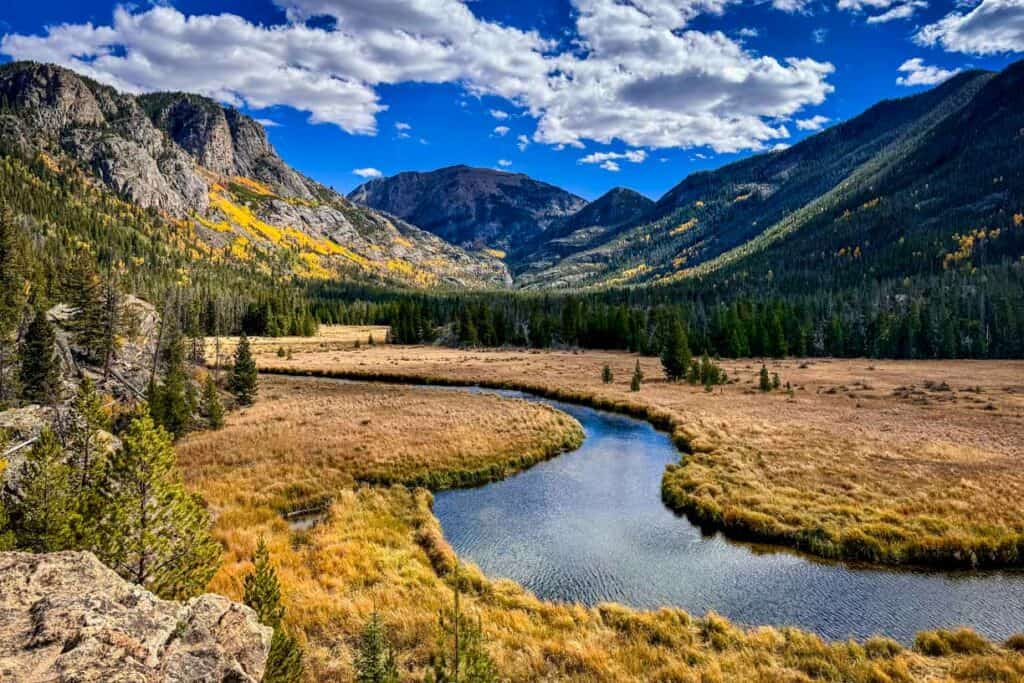
You will find the most things to do in Rocky Mountain National Park from May through October. At this time, temperatures are pleasant, sunny days are common, and snow is mostly melted. The roads are open, hiking trails are accessible, and the park feels alive with wildlife activity and colorful flora.
Since May through October is the best time to visit, these months mark peak visiting season. So, you will inevitably face crowds during this time.
Rocky Mountain National Park is a winter wonderland from November through April. If you really want to avoid the crowds and don’t mind donning some snowshoes, winter and spring can be a good time to visit.
Psst! Did you know Rocky Mountain is one of the best national parks to visit in winter?
How to avoid the crowds during peak season
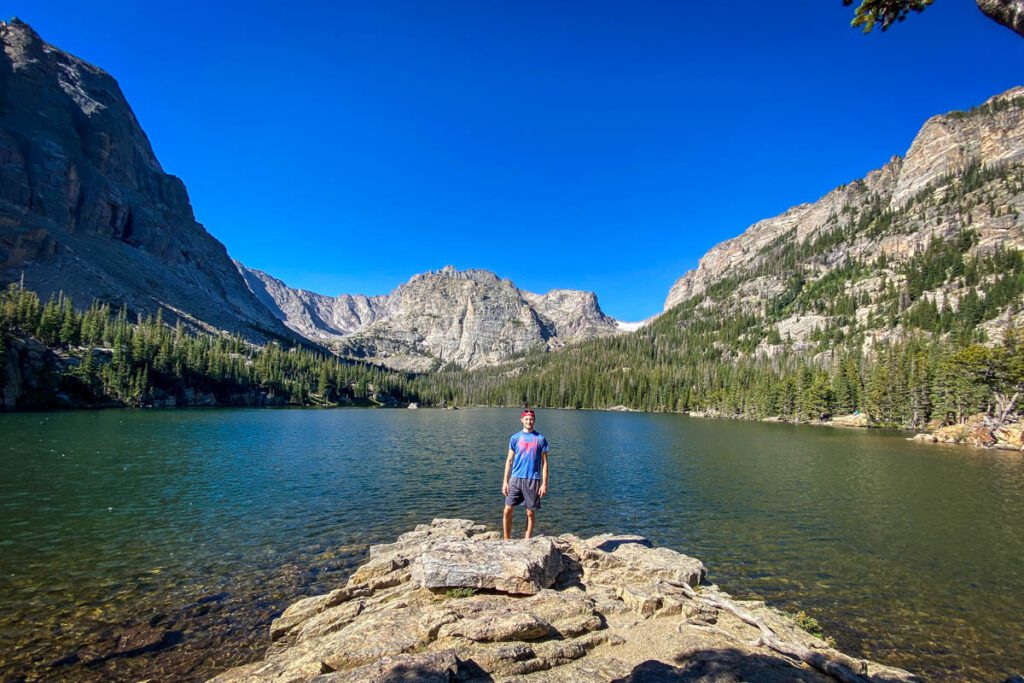
Follow these tips to get some more “alone time” with the park during peak season:
- Start early in the day. Wake up and start your day before sunrise whenever possible.
- Complete the park’s short, more popular hikes in the evening. Afternoon thunderstorms are typically gone by 5 p.m., and the trails and parking areas see far less people in the evening.
- Visit the less popular areas. The park’s hotspots are great, but don’t be afraid to seek out the trail less-traveled!
- Visit during the week. Weekends at RMNP during peak season can often resemble an amusement park. So. Many. People! The weekdays are quieter. Oh, and try to avoid visiting during major U.S. holidays.
How many days do you need in Rocky Mountain National Park?
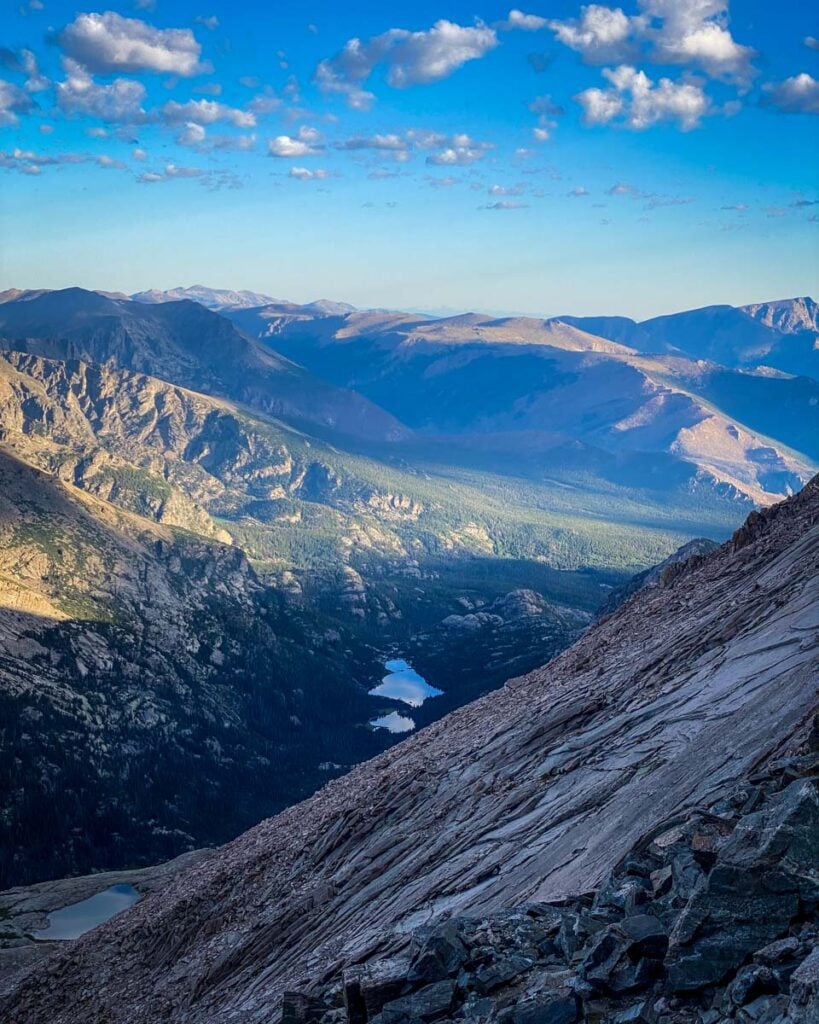
There is literally a lifetime of things to do in Rocky Mountain National Park. One day is simply not enough to do the park justice.
Not only is the park big, but there are so many things to do crammed into every nook and cranny of the park! Here’s what 1-5 days looks like at Rocky Mountain National Park:
- 1 day: Visit the Bear Lake area and do a quick hike or two. Not enough time
- 2 days: Visit Bear Lake, maybe summit Longs Peak or do a longer hike in the park, and spend a night in the park. Not bad
- 3 days: Days 1 & 2 plus a leisurely day on Trail Ridge, in the park’s alpine tundra. Plus: wildlife viewing and watching a sunrise/sunset! Getting there
- 4 days: Now you can do a hike or two in the park’s lesser-appreciated areas. That’s more like it!
- 5 days: You can even chill out at your campsite or in Estes Park and not feel guilty. Perfection
Check out our 3-day Rocky Mountain National Park itinerary to have all the logistics planned for the perfect trip!
Where to stay in Rocky Mountain National Park
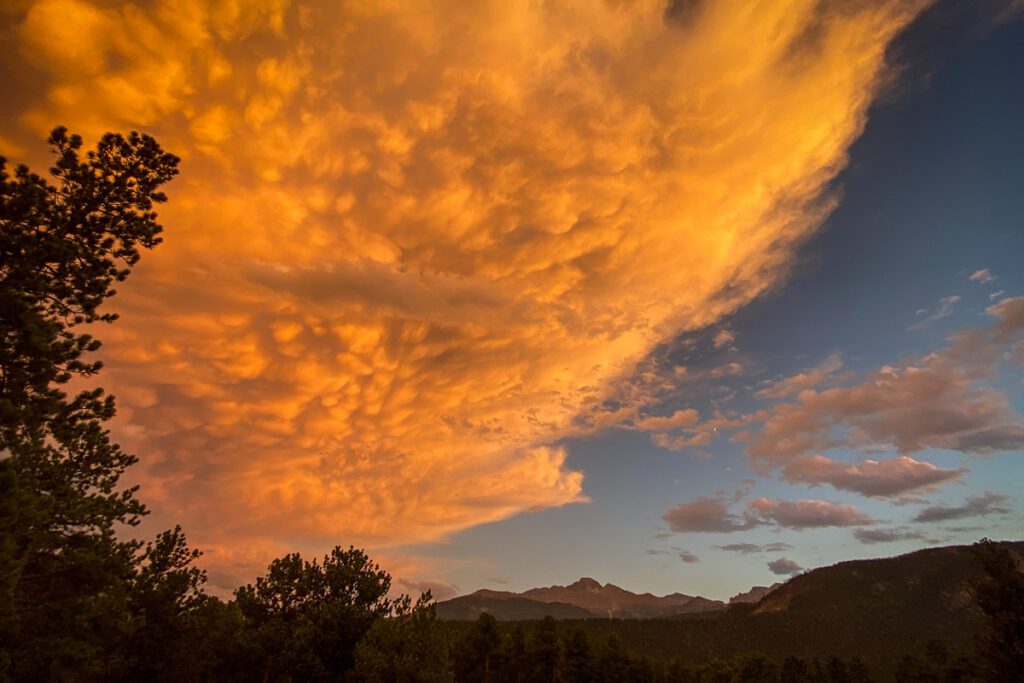
The only way to stay inside Rocky Mountain National Park is by camping. However, if you don’t want to camp, there are plenty of places near the park that offer overnight accommodations.
Due to its close proximity to several sizable towns, it’s relatively easy to find a hotel, motel, campground, or Airbnb near the park.
- Look to Estes Park for lodging near the east side of the park.
- Look to Grand Lake for lodging near the west side of the park.
Campgrounds in Rocky Mountain National Park
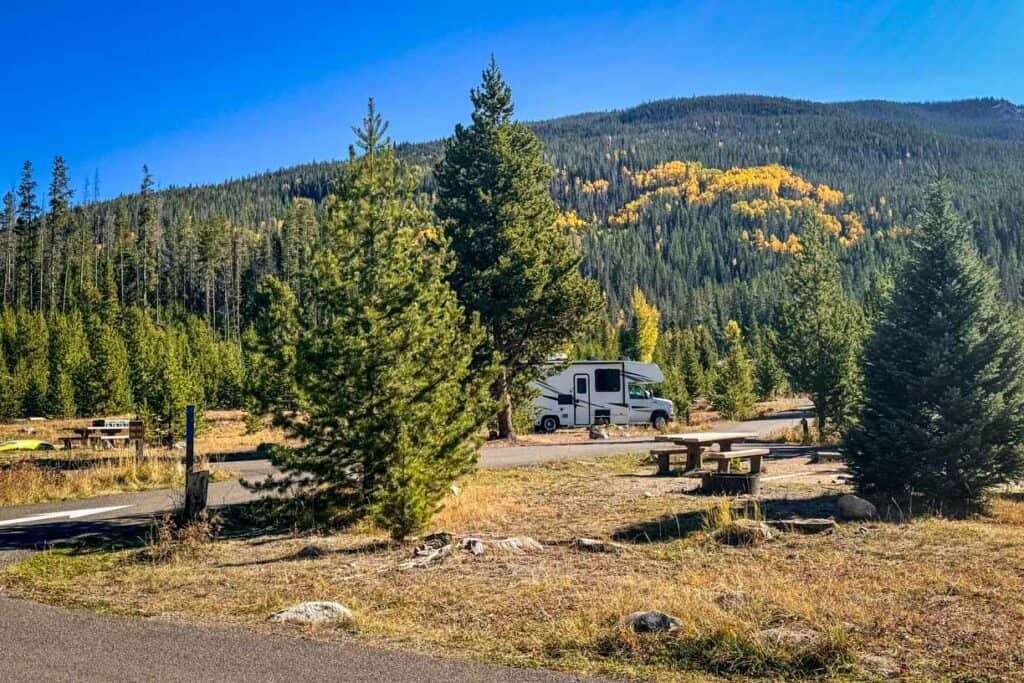
The campgrounds in Rocky Mountain National Park offer great amenities, sit in close proximity to popular trails and activities, and often have beautiful views.
When we visited, we stayed at Moraine Park campground. It offered a fantastic view of Longs Peak, allowing us to kick back and study from afar the route we took to climb the peak earlier in the trip. Deer often wandered around our campsite, munching on grass and paying no attention to us in our camp chairs.
Rocky Mountain National Park features 5 campgrounds, 4 of which accept advanced reservations. Campground reservations are made available 6 months in advance. Longs Peak campground is the only campground that does not accept reservations.
- Moraine Park campground: Of the park’s 5 campgrounds, this is arguably most central to the popular activities on the park’s eastern side. In addition, its placement in an open meadow with few trees provides awesome views of the park around you. Many of the campsites provide a great vantage point to watch Longs Peak as the sun sets.
- Glacier Basin campground: This spot offers the most convenient access to the Bear Lake area. The campground is walking distance from the Park & Ride, where shuttles take visitors to Bear Lake and Moraine Park. Here, you are surrounded by a pine forest and can find great views of the mountains to the west.
- Aspenglen campground: Nestled in a forest in the park’s northeastern corner, this campground is near the Fall River Visitor Center. Here, you can catch glimpses of some of the rocky peaks around you. The campground sits in close proximity to Sheep Lakes, where wildlife can commonly be found in the early morning or late evening.
- Longs Peak campground: This is the closest spot you’ll get to stay near the Longs Peak trailhead. This campground is first-come, first-serve only. The campground often fills up fast with hikers ready to summit Longs Peak early in the morning.
- Timber Creek campground: The only campground in the park’s western side. It has 98 sites, offers beautiful scenery of the lesser-visited west side, and sits in close proximity to many trailheads. This is the only reservable campground where your reservation does not include Bear Lake area permits.
Important to note: Campgrounds inside the park typically fill up quickly. Reserve campsites several months in advance of your stay in the park. Do not show up to a campground on the day of your visit without a reservation, because there’s a 99.9% chance there won’t be an available site.
Psst! Katie and Ben here again…
A note on campgrounds outside the park
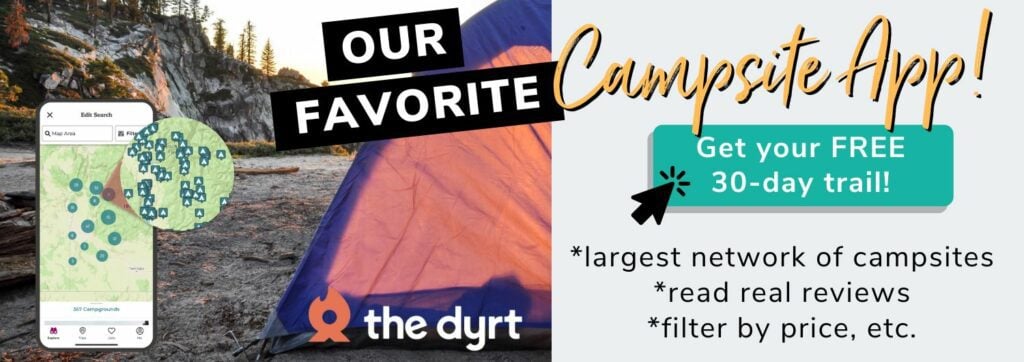
Camping inside Rocky Mountain National Park is more convenient but, if you aren’t able to get a spot in the park, there are many campgrounds located around the park as well.
If you’re traveling in a campervan or simply hoping to save money on your visit to Rocky Mountain National Park by camping along the way, we have a deal for you!
The Dyrt is our favorite campsite locating app with the largest database of campgrounds (44,000+ campsites and counting!) and over 1 million user-submitted reviews. Plus, it’s super user-friendly, and has some pretty cool features, like outdoor gear contests and forums to connect and seek advice from fellow campers, that you won’t find on any other camping app.
Try their Pro Membership for FREE for 30 days and gain access to the offline version of the app, utilize their trip planning feature AND get exclusive discounts on campsites and gear!
What to pack for visiting Rocky Mountain National Park
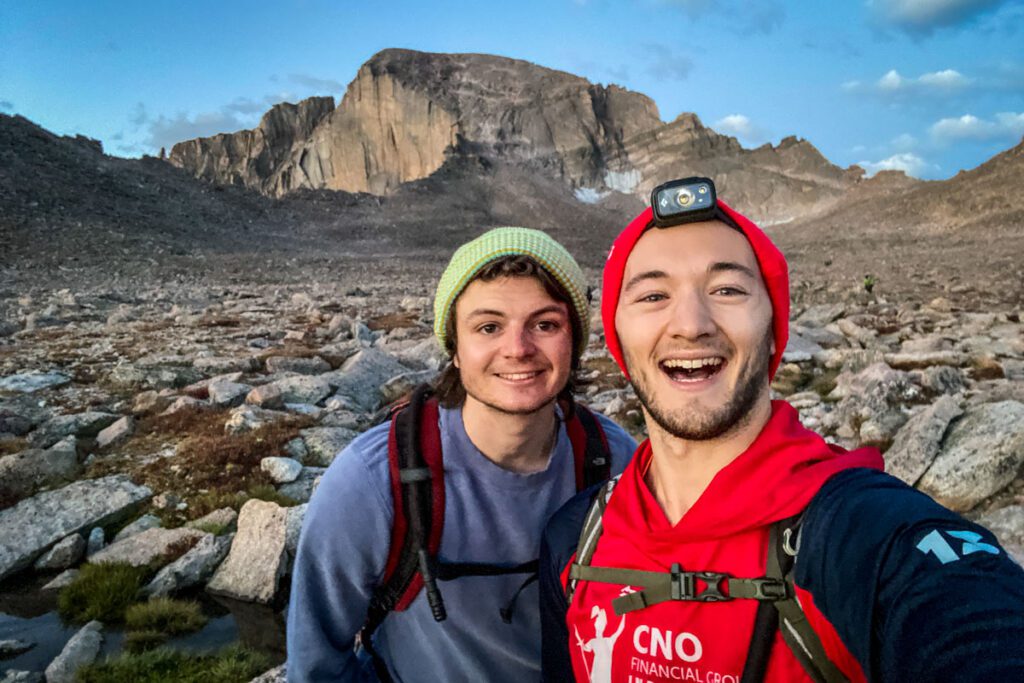
- Comfortable daypack
- Hydration pack and/or water bottles
- We take our insulated Hydroflask water bottles with us everywhere, but for hiking, we especially love the Grayl water purifying bottles
- Sun protection: sunscreen, sunglasses, hat
- Bug spray (we prefer the natural stuff)
- Camera (be sure you have a bag so you can put away your camera while hiking!)
- Tripod (this is our favorite for hiking)
- Hiking shoes or boots
- Trekking poles and/or microspikes can be useful depending on the season in case you encounter snow on the trails, especially at higher elevations
- Bear spray, in case you encounter any aggressive bears
- Comfortable hiking clothes (always dress in layers!)
- A towel for when you jump in a lake
- Snacks
- Check out some of our favorite hiking snacks for ideas!
- AllTrails Pro (or download Google Maps offline for the area in case you lose service)
- Mountain Project or an RMNP climbing guidebook if you plan to climb
- Garmin Inreach (or similar device) to call for help in an emergency, especially while summiting mountains
Tips for visiting Rocky Mountain National Park
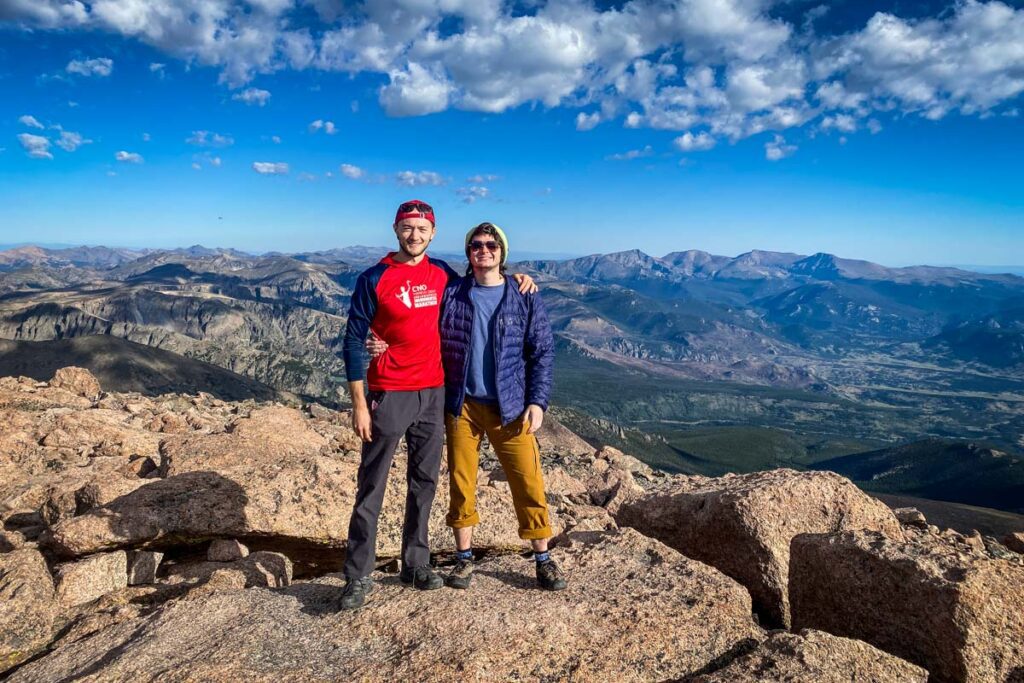
- Start your day early during peak season to avoid the worst of the park’s crowds
- Don’t be afraid to use the Park & Ride to avoid parking fiascos
- Sometimes, doing an activity or a hike in the evening is a good strategy to avoid crowds and lines
- When hiking, get below the tree line by noon. This allows you to be sheltered in case of surprise thunderstorms, which are common during summer afternoons in the Rockies
- Always check the forecast before embarking on a long hike
- Do not feed wildlife!!!
- Plan ahead. It’s a good idea to plan your trip to Rocky Mountain National Park several months before you arrive. Accommodations – especially campgrounds – are often fully booked far in advance
- Be flexible with your plans
- Take time (1-3 days) to acclimate to Colorado’s high altitude before embarking on any strenuous hikes
Roundup of the best things to do in Rocky Mountain National Park
Here’s a recap of all the best things to do in Rocky Mountain National Park so you can see everything in one place.
- Bear Lake Road Corridor
- Trail Ridge Road
- Alpine Visitor Center
- Longs Peak
- Wildlife
- Alpine lakes
- Bouldering
- Continental Divide
- Camping
- Sunrises and sunsets
- Backpacking
- East Inlet Trail
- Biking
- Estes Park
- Hike a 13er
- Winter in the park
- Lesser-visited areas of the park
About the guest author
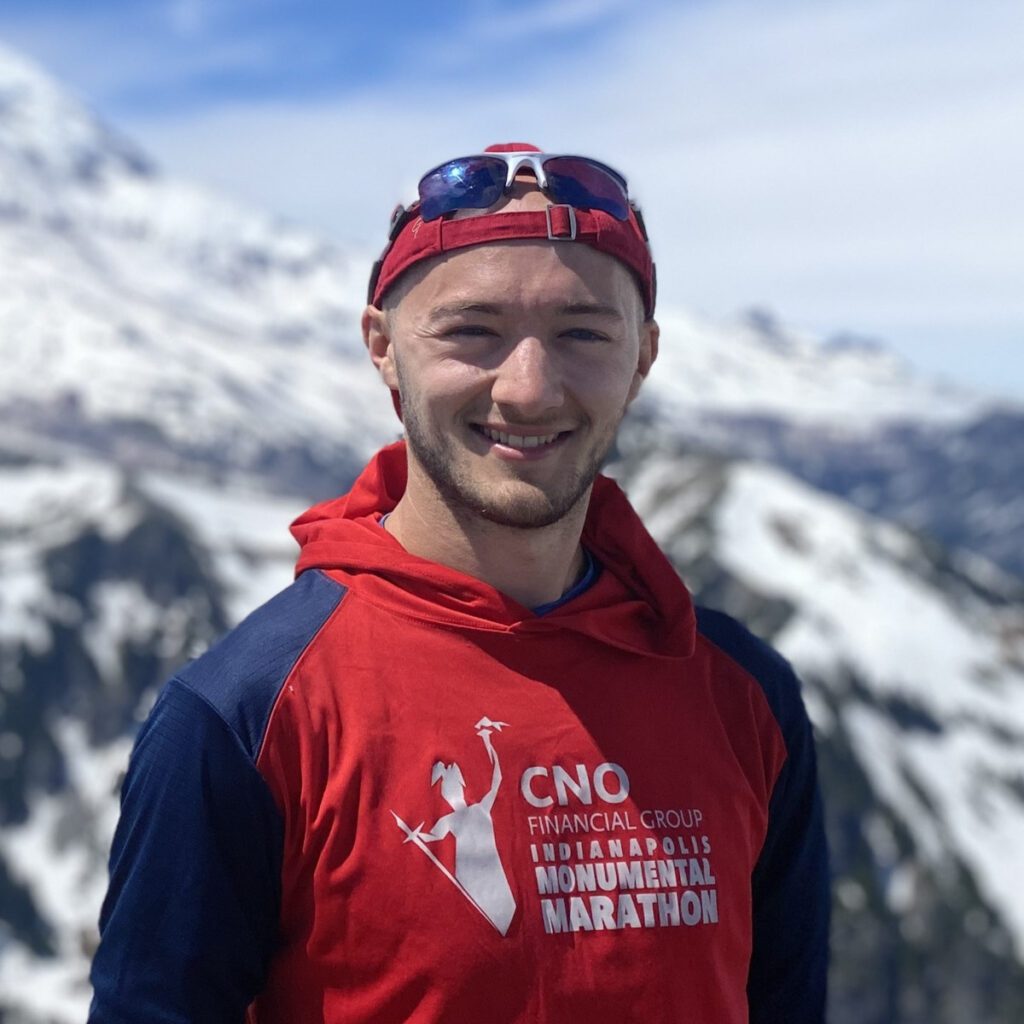
Paul is an outdoor enthusiast, blogger & vlogger, and engineer living in Indianapolis, Indiana. In 2018, he began a quest to visit every national park in the USA, and has since made it to 26… with plans to visit 7 more in 2023. He documents his travels and shares tips for visiting the parks on his website, Paul in the Parks. He spends his free time hiking, rock climbing, backpacking, running, cycling, and exploring the country with his fiancée, Maria, who shares his love of the outdoors.
Love exploring USA National Parks?
Us too—in fact, we’re kind of obsessed with them!
We have tons of articles, guides, and itineraries for just about every national park we’ve visited. Browse our USA National Parks homepage or click on one of our national park guides below.
- Acadia National Park, ME
- Arches National Park, UT
- Bryce Canyon National Park, UT
- Canyonlands National Park, UT
- Capitol Reef National Park, UT
- Death Valley National Park, CA & NV
- Glacier National Park, MT
- Grand Teton National Park, WY
- Joshua Tree National Park, CA
- North Cascades National Park, WA
- Olympic National Park, WA
- Yellowstone National Park, WY
- Yosemite National Park, CA
- Zion National Park, UT
Save this article for later on Pinterest!
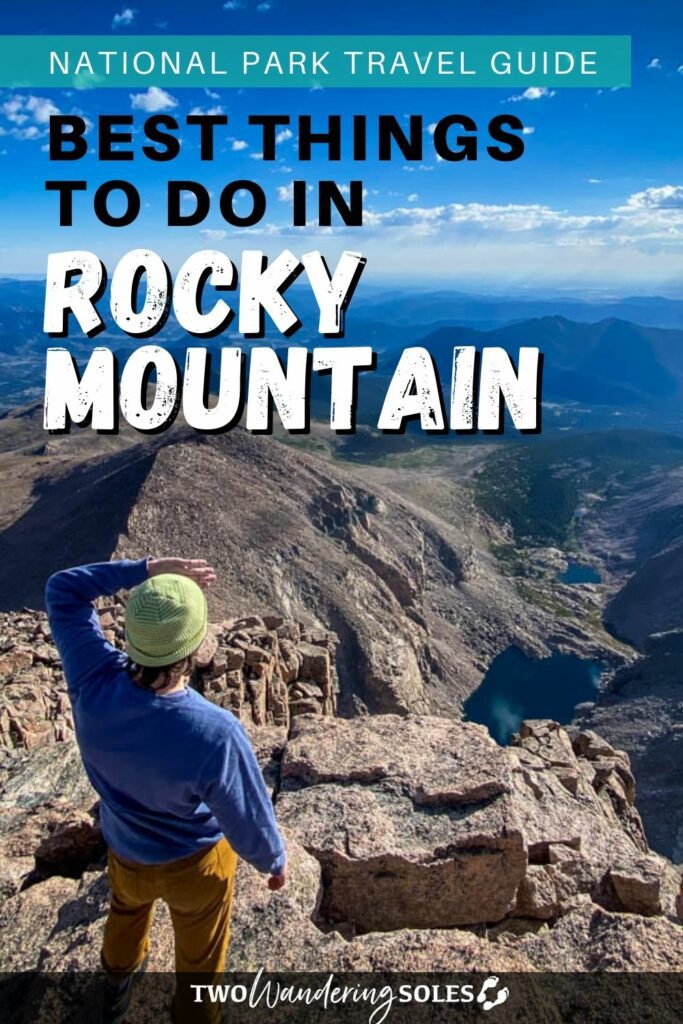
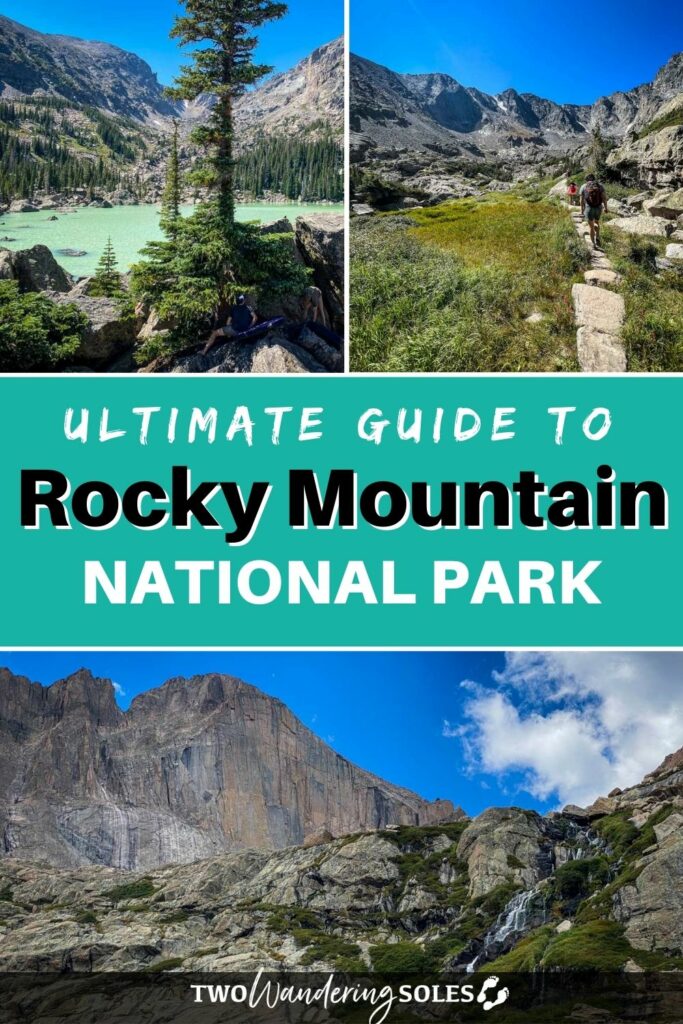
We want to hear from you!
Which of these things to do in Rocky Mountain National Park is at the top of your list? Have questions about planning your trip to RMNP? Anything you think we missed? Let us know in the comments below and we’ll do our best to get back to you!

I love your vivid depiction of Rocky Mountain National Park! It sounds like an incredible destination filled with breathtaking scenery. Your guide promises to be a fantastic resource for anyone eager to explore this stunning area, and I appreciate that you’re including helpful tips to enhance the visit. I’m excited to learn about the best things to do in the park—it’s sure to inspire many adventurers! Thank you for sharing your insights!